Nature Play in Primary School: Supporting Holistic Development Through Outdoor Learning
Abstract
1. Introduction
1.1. Background and Study Aims
- What effect does a 10-week nature play intervention have on Year One students’ academic performance, well-being, school engagement, and connection to nature?
- What do children say about nature play and its impact on their lives?
1.2. Why Nature Play Matters Now
1.3. Children as Active Meaning-Makers
1.4. The GINGER Model: Understanding Children’s Holistic Development in Nature Play
- Growth: Conditions that foster progress in learning, development, and physical health.
- Identity: Personal characteristics, beliefs, and values shaping children’s experiences.
- Nurturing Nature: The sensory and emotional support offered by natural environments.
- Genuine Connection: Relationships with peers, educators, family, and place.
- Experientia: Derived from the Latin for “knowledge gained through practice and repeated trials” (Lewis & Short, 1879/n.d.). In GINGER, it refers to the learning through child-led, unstructured, and embodied play in nature.
- Reciprocity: Mutual respect and care between humans and the more-than-human world.
2. Materials and Methods
2.1. Study Design
2.2. Participants
2.3. Intervention
2.4. Ethics and Consent
2.5. Measures
2.6. Data Analysis
2.7. Data Management and Confidentiality
3. Results
3.1. Academic Performance

3.2. Well-Being

3.3. School Engagement

3.4. Sense of Belonging

3.5. Nature Pedagogies

“[Child] didn’t like getting dirty at first but by the end… didn’t care anymore.”
“It is good for parents to see that their children can cope in the rain and cold!”
3.6. Additional Insights
4. Discussion
4.1. Well-Being: Beyond Comfort to Developmental Challenge
4.2. Engagement: Embodied, Multisensory, and Autonomous
4.3. Belonging: Affective and Reciprocal
4.4. Nature Pedagogies: Designing Conditions for Development
4.5. Nature Play and School as Complementary
4.6. Beyond Romantic Views of Nature
4.7. Strengths and Limitations
4.8. Recommendations
- Embed nature play into early primary curricula as a core pedagogical approach, not merely an enrichment activity.
- Treat outdoor learning as integral to academic development, well-being, engagement, and sense of belonging.
- Include nature play as a pedagogical bridge across key transition points, for example, from preschool to primary school.
- Prioritize nature play through targeted policy and investment.
- Fund the creation of accessible, safe, natural spaces in school environments.
- Provide professional development for educators to embed nature pedagogies confidently and effectively.
- Recognize and support nature play’s broad developmental benefits, ensuring equity of access across all school contexts.
- Expand research through longitudinal mixed-methods studies in diverse educational settings.
- Center children’s voices through child-led methods such as interviews or digital storytelling.
- Investigate demographic variables (for example, gender, socio-economic status) to understand how nature play is experienced across different groups.
5. Conclusions
Author Contributions
Funding
Institutional Review Board Statement
Informed Consent Statement
Data Availability Statement
Acknowledgments
Conflicts of Interest
Abbreviations
| ACARA | Australian Curriculum, Assessment and Reporting Authority |
| COVID-19 | Coronavirus Disease 2019 |
| PBL | Play-based learning |
| PNEW | Play, Nature, Engagement and Well-being questionnaire |
| PNEW–B | Play, Nature, Engagement, and Well-being—Bush School questionnaire |
Appendix A
| Elements | Throughlines | |||
|---|---|---|---|---|
| Well-Being | Engagement | Belonging | Nature Pedagogies | |
| Components | ||||
| Growth | accomplishment; competence; emotion; outcomes; physical health | agentic engagement; cognitive engagement; purpose | - | - |
| Identity | positivity | autonomy; behavioral engagement; social engagement | cultural belonging; social belonging | individual constraints |
| Nurturing nature | calming; restorative | - | physical belonging | timelessness |
| Genuine Connection | relatedness; relationships | - | affective engagement; professional love | harmony |
| Experientia | - | emotional engagement; flow | spatial belonging | affordances; environmental constraints; task constraints |
| Reciprocity | - | - | ethical belonging; grounded; spiritual belonging | negotiated control |
| Research Question | Objective | Quantitative Methods | Qualitative Methods | Aligned GINGER Element and Components |
|---|---|---|---|---|
| What effect does a 10-week nature play intervention have on Year One students’ academic performance, well-being, school engagement, and connection to nature? | To understand how nature play affects children’s reading and mathematics achievement, levels of well-being and school engagement, as well as connection to nature | PNEW questionnaire Class assessments Demographic data collected through closed questions in the parent survey | Classroom teachers’ semi-structured interviews and reflective journal, Bush School teachers’ reflective journal, parent responses to open-ended survey questions, researcher field notes, and diary | Growth: agentic engagement, cognitive engagement, emotion, outcomes, physical health Identity: behavioral engagement, individual constraints, social engagement Nurturing nature: calming, restorative, timelessness Genuine connections: harmony, relatedness, relationships, professional love Experientia: affordances, emotional engagement, environmental and task constraints, flow, spatial belonging Reciprocity: ethical belonging, grounded, negotiated control, spiritual belonging |
| What do children say about nature play and its impact on their lives? | To understand how children see nature play affecting them and their lives | Children’s journals PNEW–B questionnaire Academic results | Growth: accomplishments, cognitive engagement, competence, emotion, physical health, purpose Identity: autonomy, cultural belonging, individual constraints, positivity, social belonging, social engagement Nurturing nature: calming, physical belonging, restorative, timelessness Genuine connections: affective engagement, harmony, relatedness, relationships Experientia: affordances, emotional engagement, environmental and task constraints, flow, spatial belonging Reciprocity: ethical belonging, grounded, negotiated control, spiritual belonging |
Appendix B
| Questionnaire | Item Number | Item |
|---|---|---|
| Items common to PNEW and PNEW–B | 1 | I feel happy |
| 2 | Being at school makes me happy | |
| 3 | I have lots of friends at school | |
| 4 | Kids at my school help each other, even if they are not friends | |
| 5 | I like talking to the teachers at my school | |
| 6 | Teachers at my school are there for me when I need them | |
| 7 | I feel like I belong in this school | |
| 8 | I can do things well at school | |
| 9 | School is important as it helps me learn | |
| 10 | I like school | |
| 11 | I find the things I do at school really interesting | |
| 12 | I find it easy to concentrate at school | |
| 13 | I find it easier to concentrate at school after recess | |
| 14 | I feel free to choose what activities I do at school | |
| 15 | I do the things I do at school because I have to, not because I want to | |
| 16 | I try my best at school | |
| 17 | I find it easier to try my best at school after recess | |
| 18 | When school is hard, I try my best | |
| 19 | I work well with other kids in my class | |
| 20 | At school I get so involved in activities I forget about everything else | |
| 21 | Being in nature makes me very happy | |
| 22 | Spending time in nature is very important to me | |
| 23 | I find being in nature really amazing | |
| 24 | I feel part of nature | |
| 25 | I play with lots of kids at school | |
| 26 | Kids at my school ask me to play with them | |
| 27 | I can play lots of different things at school | |
| PNEW–B only items | 28 | Being at Bush School makes me happy |
| 29 | Kids at Bush School help each other even if they are not friends | |
| 30 | Kids help each other more at school than Bush School | |
| 31 | Teachers at Bush School are there for me when I need them | |
| 32 | I can do things well at Bush School | |
| 33 | Bush School is important as it helps me learn | |
| 34 | I like Bush School | |
| 35 | I like school more than Bush School | |
| 36 | I find the things I do at Bush School really interesting | |
| 37 | I find the things I do at school more interesting than the things I do at Bush School | |
| 38 | I find it easier to concentrate in class after being at Bush School | |
| 39 | I feel free to choose what activities I do at Bush School | |
| 40 | I do the things I do at Bush School because I have to, not because I want to | |
| 41 | I try my best at Bush School | |
| 42 | I find it easier to try my best at school after being at Bush School | |
| 43 | When Bush School is hard, I try my best | |
| 44 | At Bush School I get so involved in activities I forget about everything else | |
| 45 | I like playing in nature at Bush School | |
| 46 | I play with lots of kids at Bush School | |
| 47 | I find it easier to play with kids at school than Bush School | |
| 48 | I can play lots of different things at Bush School | |
| 49 | Play at school is more interesting than play at Bush School |
Appendix C
| Item | Time Point | Mean Difference | p-Value Difference | Difference Girls (95% CI) | Difference Boys (95% CI) | p-Value Gender |
|---|---|---|---|---|---|---|
| Being at school makes me happy | Pre-Post | −0.08 | 0.699 | −0.11 (−0.68, 0.46) | −0.25 (−0.89, 0.39) | 0.680 |
| Post-Follow-up | 0.36 | 0.033 | 0.54 (0.03, 1.04) | 0.45 (−0.11, 1.01) | 0.780 | |
| I have lots of friends at school | Pre-Post | −0.16 | 0.398 | −0.52 (−0.97, −0.08) | −0.47 (−0.97, 0.03) | 0.830 |
| Post-Follow-up | 0.16 | 0.359 | 0.52 (0.10, 0.93) | 0.28 (−0.19, 0.74) | 0.340 | |
| I like talking to the teachers at my school | Pre-Post | 0.20 | 0.234 | 0.35 (−0.10, 0.81) | −0.10, (−0.60, 0.41) | 0.100 |
| Post-Follow-up | 0.16 | 0.398 | 0.23 (−0.21, 0.68) | 0.67 (0.17, 1.17) | 0.110 | |
| Teachers at my school are there for me when I need them | Pre-Post | 0.12 | 0.375 | 0.13 (−0.19, 0.46) | 0.22 (−0.15, 0.58) | 0.660 |
| Post-Follow-up | −0.04 | 1.000 | 0.11 (−0.51, 0.29) | 0.04 (−0.49, 0.40) | 0.770 | |
| I feel like I belong in this school | Pre-Post | −0.16 | 0.289 | −0.45 (−0.83, −0.07) | −0.17 (−0.59, 0.25) | 0.220 |
| Post-Follow-up | 0.04 | 1.000 | 0.32 (−0.16, 0.80) | −0.05 (−0.58, 0.49) | 0.210 | |
| I feel free to choose what activities I do at school | Pre-Post | −0.20 | 0.284 | 0.41 (−0.17, 0.98) | −0.37 (−1.01, 0.28) | 0.033 |
| Post-Follow-up | −0.32 | 0.076 | −0.35 (−0.90, 0.21) | −0.32 (−0.94, 0.31) | 0.930 | |
| I do the things I do at school because I have to, not because I want to | Pre-Post | −0.08 | 0.581 | −0.32 (−0.88, 0.24) | 0.05 (−0.58, 0.67) | 0.280 |
| Post-Follow-up | −0.08 | 0.774 | −0.04 (−0.51, 0.43) | 0.26 (−0.27, 0.78) | 0.290 | |
| I find it easier to try my best at school after recess | Pre-Post | −0.12 | 0.541 | 0.24 (−0.34, 0.82) | −0.54 (−1.18, 0.11) | 0.033 |
| Post-Follow-up | 0.08 | 0.807 | 0.31 (−0.28, 0.89) | −0.03 (−0.68, 0.62) | 0.340 | |
| I work well with other kids in my class | Pre-Post | −0.24 | 0.183 | −0.61 (−1.1, −0.11) | −0.35 (−0.91, 0.20) | 0.400 |
| Post-Follow-up | 0.04 | 1.00 | 0.12 (−0.2, 0.44) | 0.16 (−0.52, 0.19) | 0.150 | |
| At school I get so involved in activities I forget about everything else | Pre-Post | 0.08 | 0.887 | 0.49 (−0.14, 1.11) | 0.12 (−0.57, 0.81) | 0.330 |
| Post-Follow-up | 0.24 | 0.231 | −0.15 (−0.77, 0.47) | 0.61 (−0.08, 1.30) | 0.049 | |
| Spending time in nature is very important to me | Pre-Post | −0.08 | 0.508 | −0.15 (−0.65, 0.35) | 0.21 (−0.35, 0.77) | 0.230 |
| Post-Follow-up | 0.04 | 1.00 | 0.26 (−0.17, 0.68) | 0.24 (−0.24, 0.72) | 0.960 | |
| I find being in nature really amazing | Pre-Post | −0.08 | 0.727 | −0.17 (−0.58, 0.25) | −0.17 (−0.63, 0.29) | 1.000 |
| Post-Follow-up | 0.12 | 0.508 | 0.21 (−0.21, 0.64) | 0.10 (−0.38, 0.58) | 0.660 | |
| I can play lots of different things at school | Pre-Post | −0.04 | 1.00 | 0.02 (−0.52, 0.57) | −0.03 (−0.64, 0.58) | 0.860 |
| Post-Follow-up | 0.08 | 0.766 | 0.23 (−0.25, 0.70) | 0.08 (−0.44, 0.61) | 0.620 | |
| Being at Bush School makes me happy | Post-Follow-up | −0.04 | 1.00 | −0.04 (−0.30, 0.22) | −0.14 (−0.43, 0.15) | 0.520 |
| Bush School is important as it helps me learn | Post-Follow-up | 0.12 | 0.508 | 0.62 (0.28, 0.97) | 0.13 (−0.26, 0.51) | 0.024 |
| I like school more than Bush School | Post-Follow-up | 0.20 | 0.253 | −0.06 (−0.64, 0.52) | −0.31 (−0.96, 0.33) | 0.470 |
| I find the things I do at Bush School really interesting | Post-Follow-up | 0.04 | 1.00 | 0.62 (0.25, 0.98) | −0.06 (−0.47, 0.35) | 0.005 |
| I find it easier to concentrate in class after being at Bush School | Post-Follow-up | −0.16 | 0.480 | 0.10, (−0.44, 0.65) | −0.54, (−1.15, 0.06) | 0.060 |
| I feel free to choose what activities I do at Bush School | Post-Follow-up | −0.36 | 0.020 | −0.46 (−0.83, −0.08) | −0.96 (−1.38, −0.54) | 0.032 |
| I like playing in nature at Bush School | Post-Follow-up | 0.16 | 0.289 | 0.54 (0.23, 0.84) | 0.45 (0.11, 0.79) | 0.640 |
| I can play lots of different things at Bush School | Post-Follow-up | 0.04 | 1.00 | −0.03 (−0.35, 0.29) | 0.24 (−0.12, 0.60) | 0.170 |
| Item | Pre (%) | Post (%) | Follow-up (%) | ||||||
|---|---|---|---|---|---|---|---|---|---|
| Never | SoT | AtT | Never | SoT | AtT | Never | SoT | AtT | |
| Being at school makes me happy | 4 | 40 | 56 | 4 | 48 | 48 | 0 | 20 | 80 |
| I have lots of friends at school | 0 | 28 | 72 | 4 | 36 | 60 | 0 | 28 | 72 |
| I like talking to the teachers at my school | 12 | 64 | 24 | 4 | 60 | 36 | 0 | 52 | 48 |
| Teachers at my school are there for me when I need them | 0 | 36 | 64 | 0 | 24 | 76 | 0 | 28 | 72 |
| I feel like I belong in this school | 0 | 20 | 80 | 0 | 36 | 64 | 0 | 32 | 68 |
| I feel free to choose what activities I do at school | 12 | 48 | 40 | 20 | 52 | 28 | 24 | 76 | 0 |
| I do things at school because I have to, not because I want to | 12 | 20 | 68 | 0 | 56 | 44 | 0 | 60 | 40 |
| I find it easier to try my best at school after recess | 20 | 36 | 44 | 16 | 56 | 28 | 16 | 48 | 36 |
| I work well with other kids in my class | 8 | 44 | 48 | 8 | 68 | 24 | 0 | 80 | 20 |
| At school I get so involved in activities I forget about everything else | 32 | 60 | 8 | 32 | 52 | 16 | 20 | 52 | 28 |
| Being in nature makes me very happy | 0 | 12 | 88 | 0 | 28 | 72 | 4 | 8 | 88 |
| Spending time in nature is important to me | 4 | 24 | 72 | 4 | 32 | 64 | 4 | 28 | 68 |
| I find being in nature really amazing | 4 | 20 | 76 | 0 | 36 | 64 | 0 | 24 | 76 |
| I can play lots of different things at school | 0 | 48 | 52 | 4 | 44 | 52 | 0 | 44 | 56 |
| Being at Bush School makes me happy | - | - | - | 0 | 16 | 84 | 0 | 20 | 80 |
| Bush School is important as it helps me learn | - | - | - | 0 | 36 | 64 | 0 | 24 | 76 |
| I like school more than Bush School | - | - | - | 52 | 40 | 8 | 36 | 52 | 12 |
| I find the things I do at Bush School really interesting | - | - | - | 0 | 32 | 68 | 4 | 20 | 76 |
| I find it easier to concentrate in class after being at Bush School | - | - | - | 8 | 36 | 56 | 16 | 36 | 48 |
| I feel free to choose what activities I do at Bush School | - | - | - | 0 | 24 | 76 | 4 | 52 | 44 |
| I like playing in nature at Bush School | - | - | - | 0 | 32 | 68 | 4 | 8 | 88 |
| I can play lots of different things at Bush School | - | - | - | 0 | 24 | 76 | 0 | 20 | 80 |
References
- Alla, K., & Truong, M. (2024). Nature play and child wellbeing. Commonwealth of Australia. Available online: https://aifs.gov.au/resources/policy-and-practice-papers/nature-play-and-child-wellbeing (accessed on 23 August 2024).
- Allee-Herndon, K. A., & Roberts, S. K. (2021). The power of purposeful play in primary grades: Adjusting pedagogy for children’s needs and academic gains. Journal of Education, 201(1), 54–63. [Google Scholar] [CrossRef]
- Arola, T., Aulake, M., Ott, A., Lindholm, M., Kouvonen, P., Virtanen, P., & Paoloniemi, R. (2023). The impacts of nature connectedness on children’s well-being: Systematic literature review. Journal of Environmental Psychology, 85, 101913. [Google Scholar] [CrossRef]
- Australian Curriculum, Assessment and Reporting Authority [ACARA]. (2025). NAPLAN national results. Available online: https://www.acara.edu.au/reporting/national-report-on-schooling-in-australia/naplan-national-results (accessed on 12 August 2025).
- Australian Psychological Society. (2022). Aussie kids’ mental health and wellbeing. Australian Psychological Society. Available online: https://psychology.org.au/getmedia/3478fa00-0a90-43ff-8d90-99a42ea53981/22aps-ps-psysch-p1.pdftarget= (accessed on 6 January 2025).
- Azevedo, R., Rosário, P., Núñez, J. C., Vallejo, G., Fuentes, S., & Magalhães, P. (2023). A school-based intervention on elementary students’ school engagement. Contemporary Educational Psychology, 73, 102148. [Google Scholar] [CrossRef]
- Ärlemalm-Hagsér, E., & Elliott, S. (2018). Transcultural explorations in nature-based early childhood education. In P. Becker, B. Humberstone, C. Loynes, & J. Schirp (Eds.), The changing world of outdoor learning in Europe (pp. 89–103). Routledge. [Google Scholar]
- Barrable, A., Booth, D., Adams, D., & Beauchamp, G. (2021). Enhancing nature connection and positive affect in children through mindful engagement with natural environments. International Journal of Environmental Research and Public Health, 18(9), 4785. [Google Scholar] [CrossRef]
- Bawaka Collective. (n.d.). Both ways of knowing. Available online: https://bawakacollective.com/ (accessed on 1 June 2025).
- Beaulieu, É., & Beno, S. (2024). Healthy childhood development through outdoor risky play: Navigating the balance with injury prevention. Canadian Paediatric Society. Available online: https://cps.ca/en/documents/position/outdoor-risky-play (accessed on 4 May 2025).
- Becker, C., Lauterbach, G., Spengler, S., Dettweiler, U., & Mess, F. (2017). Effects of regular classes in outdoor education settings: A systematic review on students’ learning, social and health dimensions. International Journal of Environmental Research and Public Health, 14(5), 485. [Google Scholar] [CrossRef]
- Braun, V., & Clarke, V. (2006). Using thematic analysis in psychology. Qualitative Research in Psychology, 3(2), 77–101. [Google Scholar] [CrossRef]
- Breunig, M. (2023). Slow(er) pedagogy as pandemic panacea. Journal of Leisure Studies and Recreation Education, 38(2), 154–155. [Google Scholar] [CrossRef]
- Burke, L., Jindal-Snape, D., Lindsay, A., Whyte, S., Wallace, M., Mercieca, D., McKenzie, M., & Keatch, B. (2024). Spaces for play: Listening to children’s voices. Education 3-13, 1–24. [Google Scholar] [CrossRef]
- Byman, J., Kumpulainen, K., Renlund, J., Wong, C. C., & Renshaw, P. (2023). Speculative spaces: Children exploring socio-ecological worlds with mythical nature spirits. Contemporary Issues in Early Childhood, 26(1), 70–86. [Google Scholar] [CrossRef]
- Camerini, A.-L., Albanese, E., & Marciano, L. (2022). The impact of screen time and green time on mental health in children and adolescents during the COVID-19 pandemic. Computers in Human Behavior Reports, 7, 100204. [Google Scholar] [CrossRef]
- Carlsen, K., & Clark, A. (2022). Potentialities of pedagogical documentation as an intertwined research process with children and teachers in slow pedagogies. European Early Childhood Education Research Journal, 30(2), 200–212. [Google Scholar] [CrossRef]
- Carter, C. P., Reschly, A. L., Lovelace, M. D., Appleton, J. J., & Thompson, D. (2012). Measuring student engagement among elementary students: Pilot of the student engagement instrument-elementary version. School Psychology Quarterly, 27(2), 61–73. [Google Scholar] [CrossRef] [PubMed]
- Chawla, L. (2022). Passive patient or active agent? An under-explored perspective on the benefits of time in nature for learning and wellbeing. Frontiers in Psychology, 13, 942744. [Google Scholar] [CrossRef]
- Checkoway, B. (2011). What is youth participation? Children and Youth Services Review, 33(2), 340–345. [Google Scholar] [CrossRef]
- Clark, A. (2023). Slow knowledge and the unhurried child. Time for slow pedagogies in early childhood education. Routledge. [Google Scholar] [CrossRef]
- Clark, A., & Moss, P. (2011). Listening to young children: The mosaic approach (2nd ed.). National Children’s Bureau. [Google Scholar]
- Clark, S. (2023). School refusal. Parliament of Australia. Available online: https://www.aph.gov.au/About_Parliament/Parliamentary_departments/Parliamentary_Library/pubs/rp/rp2223/SchoolRefusal#_ftn8 (accessed on 15 October 2024).
- Clay, K., Haywood, A., & Chapman, M. (2025). Grading the 2025 NAPLAN results [Audio podcast]. Available online: https://grattan.edu.au/news/grading-the-2025-naplan-results/ (accessed on 3 August 2025).
- Coates, J. K., & Pimlott-Wilson, H. (2019). Learning while playing: Children’s forest school experiences in the UK. British Educational Research Journal, 45(1), 21–40. [Google Scholar] [CrossRef]
- Cohen, L., Manion, L., & Morrison, K. (2018). Research methods in education (8th ed.). Routledge. [Google Scholar]
- Commonwealth of Australia. (2025). AEDC national report 2024. Early childhood development in Australia. Department of Education on behalf of the Australian Government. Available online: https://www.aedc.gov.au/resources/detail/2024-aedc-national-report (accessed on 18 July 2025).
- Cooley, S. J., Burns, V. E., & Cumming, J. (2016). Using outdoor adventure education to develop students’ groupwork skills: A quantitative exploration of reaction and learning. Journal of Experiential Education, 39(4), 329–354. [Google Scholar] [CrossRef]
- Csikszentmihalyi, M. (2008). Flow: The psychology of optimal experience. Perennial. [Google Scholar]
- Cutter-Mackenzie-Knowles, A., Malone, K., & Barratt Hacking, E. (2020). Childhoodnature: An assemblage adventure. In A. Cutter-Mackenzie-Knowles, K. Malone, & E. Barratt Hacking (Eds.), Research handbook on childhoodnature. Assemblages of childhood and nature research (pp. 1–15). Springer. [Google Scholar] [CrossRef]
- Dabaja, Z. (2022a). Reviewing two decades of research on the Forest School impact on children: The sequel. Education 3-13, 50(6), 737–750. [Google Scholar] [CrossRef]
- Dabaja, Z. (2022b). The Forest School impact on children: Reviewing two decades of research. Education 3-13, 50(5), 640–653. [Google Scholar] [CrossRef]
- Dankiw, K. A., Kumar, S., Baldock, K. L., & Tsiros, M. D. (2023). Do children play differently in nature play compared to manufactured play spaces? A quantative descriptive study. International Journal of Early Childhood, 56(3), 535–554. [Google Scholar] [CrossRef]
- Dankiw, K. A., Tsiros, M. D., Baldock, K., & Kumar, S. (2020). The impacts of unstructured nature play on health in early childhood development: A systematic review. PLoS ONE, 15(2), e0229006. [Google Scholar] [CrossRef] [PubMed]
- Dealey, R. P., & Stone, M. H. (2017). Exploring out-of-school play and educational readiness. Early Childhood Education Journal, 46, 201–208. [Google Scholar] [CrossRef]
- Dean, S. N., & Wenner, J. A. (2025). Patterns and representation in play-based learning: A systematic meta-synthesis of empirical studies in K-13+ settings. Frontiers in Education, 10, 1557001. [Google Scholar] [CrossRef]
- Donison, L., & Halsall, T. (2023). ‘I’d rather learn outside because nature can teach you so many more things than being inside’: Outdoor learning experiences of young children and educators. Journal of Childhood, Education & Society, 4(3), 373–390. [Google Scholar] [CrossRef]
- Duque, I., Martins, F. M. L., & Clemente, F. M. (2016). Outdoor play and interaction skills in early childhood education: Approaching for measuring using social network analysis. Journal of Physical Education and Sport, 16(4), 1266. [Google Scholar] [CrossRef]
- Dutton, J., Carlsen, A., Maitlis, S., Pressman S, D., & Parks, A. (2025). Building high-quality connections. In S. D. Pressman, & A. C. Parks (Eds.), More activities for teaching positive psychology: A guide for instructors (pp. 261–270). American Psychological Association. [Google Scholar] [CrossRef]
- Early Life Foundations. (n.d.). What is walker learning? Walker Learning. Available online: https://earlylife.com.au/about-walker-learning/ (accessed on 17 February 2025).
- Elkind, D. (2007). The hurried child: Growing up too fast too soon (3rd ed., 25th anniversary ed.). Da Capo Press. [Google Scholar]
- Fetters, M. D., & Molina-Azorin, J. F. (2017). The journal of mixed methods research starts a new decade: The mixed methods research integration trilogy and its dimensions. Journal of Mixed Methods Research, 11(3), 291–307. [Google Scholar] [CrossRef]
- Frances, L., Quinn, F., Elliott, S., & Bird, J. (2024). Outdoor learning across the early years in Australia: Inconsistencies, challenges, and recommendations. The Australian Educational Researcher, 51, 2141–2159. [Google Scholar] [CrossRef]
- Fredrickson, B. L. (2013). Love 2.0. Creating happiness and health in moments of connection. Penguin Random House LLC. [Google Scholar]
- Fyfe-Johnson, A. L., Hazlehurst, M. F., Perrins, S. P., Bratman, G. N., Thomas, R., Garrett, K. A., Hafferty, K. R., Cullaz, T. M., Marcuse, E. K., & Tandon, P. S. (2021). Nature and children’s health: A systematic review. Pediatrics, 148(4), 2020049155. [Google Scholar] [CrossRef]
- Gallagher, S. (2007). The natural philosophy of agency. Philosophy Compass, 2(2), 347–357. [Google Scholar] [CrossRef]
- Gallagher, S., Thomas, L. E., & Robinson, M. D. (2021). The 4Es and the 4As (affect, agency, affordance, autonomy) in the meshed architecture of social cognition. In M. D. Robinson, & L. E. Thomas (Eds.), Handbook of embodied psychology (pp. 357–379). Springer International Publishing AG. [Google Scholar] [CrossRef]
- Gibson, J. J. (1979). The ecological approach to visual perception. Lawrence Erlbaum Associates. [Google Scholar]
- Gill, T. (2014). The benefits of children’s engagement with nature: A systematic literature review. Children, Youth and Environments, 24(2), 10–34. [Google Scholar] [CrossRef]
- Goldsmith, L. (2021). Using framework analysis in applied qualitative research. Qualitative Report, 26(6), 2061–2076. [Google Scholar] [CrossRef]
- Gonski Institute for Education. (2019). Conversation kicker #1: An hour of play. UNSW. [Google Scholar]
- Gonski Institute for Education. (2020). Growing up digital in Australia: Phase 1 technical report. Gonski Institute for Education. UNSW. Available online: https://apo.org.au/node/303281 (accessed on 28 March 2021).
- Gray, P. (2011). The decline of play and the rise of psychopathology in children and adolescents. American Journal of Play, 3(4), 443–463. [Google Scholar]
- Gray, T. (2018). Outdoor learning: Not new, just newly important. Curriculum Perspectives, 38, 145–149. [Google Scholar] [CrossRef]
- Gray, T., & Birrell, C. (2015). ‘Touched by the earth’: A place-based outdoor learning programme incorporating the Arts. Journal of Adventure Education and Outdoor Learning, 15(4), 330–349. [Google Scholar] [CrossRef]
- Gunnar, M. R., & Bowen, M. (2021). What was learned from studying the effects of early institutional deprivation. Pharmacology, Biochemistry and Behavior, 210, 173272. [Google Scholar] [CrossRef] [PubMed]
- Gutiérrez, K. D. (2020). When learning as movement meets learning on the move. Cognition and Instruction, 38(3), 427–433. [Google Scholar] [CrossRef]
- Haidt, J. (2024). The anxious generation. How the great rewiring of childhood is causing an epidemic of mental illness. Allen Lane. [Google Scholar]
- Hamilton, L. M. (2023). The pandemic has waned, but a global youth mental health crisis persists. The OECD Forum Network. Available online: http://www.oecd-forum.org/posts/the-pandemic-has-waned-but-a-global-youth-mental-health-crisis-persists (accessed on 12 November 2023).
- Harper, A., Gray, T., & Sahlberg, P. (in press). Measuring play, nature connection, engagement and wellbeing: A new self-report questionnaire for primary school students. Journal of Outdoor and Environmental Education.
- Haywood, A. (2024). Unpacking the 2024 NAPLAN results [Audio podcast]. Available online: https://grattan.edu.au/news/unpacking-the-2024-naplan-resutls/ (accessed on 2 September 2025).
- Henrich, J., Heine, S. J., & Norenzayan, A. (2010). The weirdest people in the world? Behavioral and Brain Sciences, 33(2–3), 61–83. [Google Scholar] [CrossRef]
- Hepworth, A., Haddad, H., & Edmonds, C. J. (2024). Attending 12 weekly sessions of Forest School sessions improves mood and cooperation in 7–8-year-old children. Journal of Adventure Education and Outdoor Learning, 1–20. [Google Scholar] [CrossRef]
- Hine, S. (2024). “Sometimes there are rules about what girls can do”: A rights-based exploration of primary-aged children’s constructions of gender in Forest School. Education 3-13, 52(8), 1510–1526. [Google Scholar] [CrossRef]
- Jucker, R. (2022). How to raise the standards of outdoor learning and its research. Summary of ‘the existing evidence-base about the effectiveness of outdoor learning’, by Fiennes et al. In high-quality outdoor learning. Evidence-based education outside the classroom for children, teachers and society (pp. 123–134). Springer. [Google Scholar] [CrossRef]
- Kellert, S. K., & Wilson, E. O. (Eds.). (1993). The Biophilia hypothesis. Island Press. [Google Scholar]
- Kern, M. L., Benson, L., Steinberg, E. A., & Steinberg, L. (2016). The EPOCH measure of adolescent well-being. Psychological Assessment, 28, 586–597. [Google Scholar] [CrossRef]
- Knight, S. (2013). Forest School and outdoor learning in the early years. Sage Publications. [Google Scholar]
- Kuo, M., Browning, M. H., & Penner, M. L. (2018). Do lessons in nature boost subsequent classroom engagement? Refueling students in flight. Frontiers in Psychology, 8, 2253. [Google Scholar] [CrossRef]
- Lam, S., Jimerson, S., Shin, H., Cefai, C., Veiga, F. H., Hatzichristou, C., Polychroni, F., Kikas, E., Wong, B. P. H., Stanculescu, E., Basnett, J., Duck, R., Farrell, P., Liu, Y., Negovan, V., Nelson, B., Yang, H., & Zollneritsch, J. (2016). Cultural universality and specificity of student engagement in school: The results of an international study from 12 countries. British Journal of Educational Psychology, 86(1), 137–153. [Google Scholar] [CrossRef]
- Lam, S.-F., Wong, B., Yang, H., Liu, Y., Wylie, C., Christenson, S. L., & Reschly, A. L. (2012). Understanding student engagement with a contextual model. In S. L. Christenson, A. L. Reschly, & C. Wylie (Eds.), Handbook of research on student engagement (pp. 403–419). Springer US. [Google Scholar] [CrossRef]
- LEGO Education. (2024). State of classroom engagement report. The LEGO Group. Available online: https://assets.education.lego.com/v3/assets/blt293eea581807678a/blt7f891827b13c7409/66e44540fd86f37b52200633/State_of_Classroom_Engagement_Key_Results.pdf?locale=en-au (accessed on 28 January 2025).
- Lewis, C. T., & Short, C. (n.d.). A Latin dictionary (G. Crane, Ed.). Perseus Digital Library. (Original work published 1879). Available online: https://www.perseus.tufts.edu/hopper/text?doc=Perseus:text:1999.04.0059:entry=experientia (accessed on 28 January 2025).
- Libby, M., Rosen, M., & Sedonaen, M. (2005). Building youth–adult partnerships for community change: Lessons from the Youth Leadership Institute. Journal of Community Psychology, 33(1), 111–120. [Google Scholar] [CrossRef]
- Louv, R. (2010). Last child in the woods: Saving our children from nature-deficit disorder. (Revised and updated). Atlantic Books. [Google Scholar]
- MacLure, M. (2010). The offence of theory. Journal of Education Policy, 25(2), 277–286. [Google Scholar] [CrossRef]
- Main, K., & Whatman, S. L. (2025). Christian youth adventure camps: Evidencing the potential for values-based education to THRIVE. Youth, 5(2), 36. [Google Scholar] [CrossRef]
- Mann, J., Gray, T., Truong, S., Brymer, E., Passy, R., Ho, S., Sahlberg, P., Ward, K., Bentsen, P., Curry, C., & Cowper, R. (2022). Getting out of the classroom and into nature: A systematic review of nature-specific outdoor learning on school children’s learning and development. Frontiers in Public Health, 10, 877058. [Google Scholar] [CrossRef]
- Marchant, E., Todd, C., Cooksey, R., Dredge, S., Jones, H., Reynolds, D., Stratton, G., Dwyer, R., Lyons, R., & Brophy, S. (2019). Curriculum based outdoor learning for children aged 9–11: A qualitative analysis of pupils’ and teachers’ views. PLoS ONE, 14(5), e0212242. [Google Scholar] [CrossRef]
- Marsh, H. W., Ellis, L. A., & Craven, R. G. (2002). How do preschool children feel about themselves? Unraveling measurement and multidimensional self-concept structure. Developmental Psychology, 38(3), 376–393. [Google Scholar] [CrossRef]
- Maynard, T., Waters, J., & Clement, J. (2013). Child-initiated learning, the outdoor environment and the ‘underachieving’ child. Early Years, 33(3), 212–225. [Google Scholar] [CrossRef]
- Measelle, J. R., Ablow, J. C., Cowan, P. A., & Cowan, C. P. (1998). Assessing young children’s views of their academic, social, and emotional lives: An evaluation of the self-perception scales of the Berkeley Puppet Interview. Child Development, 69, 1556–1576. [Google Scholar] [CrossRef]
- Meeuwissen, K., Logan, T., & Pino-Pasternak, D. (2025). Does play belong in primary schools? Australian teachers’ perspectives. Australian Journal of Education, 69(2), 164–179. [Google Scholar] [CrossRef]
- Merewether, J. (2015). Young children’s perspectives of outdoor learning spaces: What matters? Australasian Journal of Early Childhood, 40(1), 99–108. [Google Scholar] [CrossRef]
- Merewether, J. (2019). Listening with young children: Enchanted animism of trees, rocks, clouds (and other things). Pedagogy, Culture & Society, 27(2), 233–250. [Google Scholar] [CrossRef]
- Merewether, J., & Fleet, A. (2014). Seeking children’s perspectives: A respectful layered research approach. Early Child Development and Care, 184(6), 897–914. [Google Scholar] [CrossRef]
- Miller, N., Kumar, S., Pearce, K. L., & Baldock, K. L. (2022). The perceived benefits of and barriers to nature-based play and learning in South Australian public primary schools: A cross-sectional study. Journal of Adventure Education and Outdoor Learning, 22(4), 342–354. [Google Scholar] [CrossRef]
- Molyneux, T. M., Zeni, M., & Oberle, E. (2023). Choose your own adventure: Promoting social and emotional development through outdoor learning. Early Childhood Education Journal, 51(8), 1525–1539. [Google Scholar] [CrossRef]
- Munro Miller, R. (2025). State of play 2025. Play Australia. Available online: https://www.playaustralia.org.au/sites/default/files/State%20of%20Play_final.pdf (accessed on 12 June 2025).
- Mygind, E., & Bølling, M. (2022). Pupils’ well-being, mental and social health. In R. Jucker, & J. von Au (Eds.), High-quality outdoor learning. Evidence-based education outside the classroom for children, teachers and society (pp. 153–170). Springer. [Google Scholar] [CrossRef]
- Nicholson, S. (1971). How NOT to cheat children. The theory of loose parts. Landscape Architecture, 62, 30–34. Available online: http://media.kaboom.org/docs/documents/pdf/ip/Imagination-Playground-Theory-of-Loose-Parts-Simon-Nicholson.pdf (accessed on 22 September 2024).
- Noble, T., & McGrath, H. (2015). PROSPER: A new framework for positive education. Psychology of Well-Being, 5, 2. [Google Scholar] [CrossRef]
- Nolan, A., & Paatsch, L. (2018). (Re)affirming identities: Implementing a play-based approach to learning in the early years of schooling. International Journal of Early Years Education, 26(1), 42–55. [Google Scholar] [CrossRef]
- NSW Department of Education. (2023). Resource allocation model (RAM) in 2024. Education NSW. Available online: https://education.nsw.gov.au/content/dam/main-education/about-us/strategies-and-reports/schools-funding/resource-allocation-model/The_Resource_Allocation_Model_RAM_in_2024.pdf (accessed on 5 January 2025).
- Organisation for Economic Co-operation and Development [OECD]. (2015). Do teacher-student relations affect students’ well-being at school? PISA in Focus 50. OECD Publishing. Available online: https://www.oecd.org/en/publications/2015/04/do-teacher-student-relations-affect-students-well-being-at-school_g17a2623.html (accessed on 22 July 2023).
- Organisation for Economic Co-operation and Development [OECD]. (2023). Education at a glance 2023: OECD indicators. OECD Publishing. [Google Scholar] [CrossRef]
- Parker, R., Thomsen, B. S., & Berry, A. (2022). Learning through play at school—A framework for policy and practice. Frontiers in Psychology, 7, 751801. [Google Scholar] [CrossRef]
- Pearce, Z. R., & Miller, S. E. (2025). Embodied cognition perspectives within early executive function development. Frontiers in Cognition, 4, 1361748. [Google Scholar] [CrossRef]
- Phenice, L. A., & Griffore, R. J. (2003). Young children and the natural world. Contemporary Issues in Early Childhood, 4(2), 167–171. [Google Scholar] [CrossRef]
- Pino-James, N., Shernoff, D. J., Bressler, D. M., Larson, S. C., & Sinha, S. (2019). Instructional interventions that support student engagement: An international perspective. In Handbook of student engagement interventions. Working with disengaged students (pp. 103–119). Academic Press. [Google Scholar] [CrossRef]
- Play Wales. (2024, May 28). A play friendly school. Chwarae Cymru. Play Wales. Available online: https://play.wales/publication-library/research/a-play-friendly-school/ (accessed on 10 March 2025).
- Prins, J., van der Wilt, F., van der Veen, C., & Hovinga, D. (2022). Nature play in early childhood education: A systematic review and meta ethnography of qualitative research. Frontiers in Psychology, 13, 995164. [Google Scholar] [CrossRef]
- Qvortrup, J. (2015). A voice for children in statistical and social accounting: A plea for children’s rights to be heard. In A. James, & A. Prout (Eds.), Constructing and reconstructing childhood. Contemporary issues in the sociological study of childhood (3rd ed., pp. 74–93). Routledge. [Google Scholar] [CrossRef]
- Racine, N., McArthur, B. A., Cooke, J. E., Eirich, R., Zhu, J., & Madigan, S. (2021). Global prevalence of depressive and anxiety symptoms in children and adolescents during COVID-19. A meta-analysis. JAMA Pediatrics, 175(11), 1142–1150. [Google Scholar] [CrossRef]
- Richardson, M., Hunt, A., Hinds, J., Bragg, R., Fido, D., Petronzi, D., Barbett, L., Clitherow, T., & White, M. (2019). Measure of nature connectedness for children and adults: Validation, performance, and insights. Sustainability, 11(12), 3250. [Google Scholar] [CrossRef]
- Rodrigues, B. L. C., & Hestenes, L. L. (2025). What about the influence of outdoor quality on preschoolers’ cognitive and social skills? Early Education and Development, 36(2), 283–305. [Google Scholar] [CrossRef]
- Rosenthal, R. (1991). Meta-analytic procedures for social research. SAGE Publications, Inc. [Google Scholar] [CrossRef]
- Ryan, R. M., & Deci, E. L. (2000). Self-determination theory and the facilitation of intrinsic motivation, social development, and well-being. American Psychologist, 55(1), 68–78. [Google Scholar] [CrossRef] [PubMed]
- Sahlberg, P., & Cobbold, T. (2021). Leadership for equity and adequacy in education. School Leadership and Management, 41(4–5), 447–469. [Google Scholar] [CrossRef]
- Sahlberg, P., & Doyle, W. (2019). Let the childern play. How more play will save our schools and help children thrive. Oxford University Press. [Google Scholar]
- Schonert-Reichl, K. A., Guhn, M., Gadermann, A. M., Hymel, S., Sweiss, L., & Hertzman, C. (2013). Development and validation of the middle years development instrument (MDI): Assessing children’s well-being and assets across multiple contexts. Social Indicators Research, 114, 345–369. [Google Scholar] [CrossRef]
- Schroth, S. T. (2023). Outdoor education and group dynamics. In Outdoor education: A pathway to experiential, environmental, and sustainable learning (pp. 103–117). Springer International Publishing. [Google Scholar] [CrossRef]
- Shapiro, L. (2007). The embodied cognition research programme. Philosophy Compass, 2(2), 338–346. [Google Scholar] [CrossRef]
- Shonkoff, J. P., Phillips, D. A., & Board on Children, Y. (2000). From neurons to neighborhoods: The science of early child development. National Academy Press. [Google Scholar]
- Skene, K., O’Farrelly, C. M., Byrne, E. M., Kirby, N., Stevens, E. C., & Ramchandani, P. G. (2022). Can guidance during play enhance children’s learning anddevelopment in educational contexts? A systematic review and meta-analysis. Child Development, 93, 1162–1180. [Google Scholar] [CrossRef]
- Sonnermann, J., & Goss, P. (2020, June). COVID catch-up. Helping disadvantaged students close the equity gap. Grattan Institute. Available online: https://grattan.edu.au/wp-content/uploads/2020/06/COVID-Catch-up-Grattan-School-Education-Report.pdf (accessed on 15 June 2023).
- Stock, K. L., Cola, P. A., & Kolb, D. (2025). Sentience and experiential learning: The role of the senses in learning. EBLS Press. [Google Scholar]
- Suzuki, D. (2022). The sacred balance. Rediscovering our place in nature. 25th anniversary edition. Greystone Books Ltd. [Google Scholar]
- Taylor, A., & Pacini-Ketchabaw, V. (2015). Learning with children, ants, and worms in the Anthropocene: Towards a common world pedagogy of multispecies vulnerability. Pedagogy, Culture & Society, 23(4), 507–529. [Google Scholar] [CrossRef]
- Taylor, M. E., & Boyer, W. (2020). Play-based learning: Evidence-based research to improve children’s learning experiences in the kindergarten classroom. Early Childhood Education Journal, 48, 127–133. [Google Scholar] [CrossRef]
- Teager, W., Fox, S., & Stafford, N. (2019). How Australia can invest early and return more: A new look at the $15b cost and opportunity. Early Intervention Foundation, The Front Project and CoLab at the Telethon Kids Institute. [Google Scholar]
- Tiplady, L. S., & Menter, H. (2021). Forest School for wellbeing: An environment in which young people can ‘take what they need’. Journal of Adventure Education and Outdoor Learning, 21(2), 99–114. [Google Scholar] [CrossRef]
- Trapasso, E., Knowles, Z., Boddy, L., Newson, L., Sayers, J., & Austin, C. (2018). Exploring gender differences within forest schools as a physical activity intervention. Children, 5(10), 138. [Google Scholar] [CrossRef]
- Ulrich, R. S., Simons, R. F., Losito, B. D., Fiorito, E., Miles, M. A., & Zelson, M. (1991). Stress recovery during exposure to natural and urban environments. Journal of Environmental Psychology, 11(3), 201–230. [Google Scholar] [CrossRef]
- United Nations. (1989). Convention on the rights of the child. 1577(3). Treaty series. Available online: https://www.ohchr.org/en/instruments-mechanisms/instruments/convention-rights-child (accessed on 14 January 2025).
- Van der Kaap-Deeder, J., Soenens, B., Ryan, R. M., & Vansteenkiste, M. (2020). Manual of the basic psychological need satisfaction and frustration scale (BPNSFS). Ghent University. Available online: https://selfdeterminationtheory.org/wp-content/uploads/2022/08/BPNSFS_Complete_2022.pdf (accessed on 16 April 2022).
- Vladimirova, A. (2021). Caring in-between: Events of engagement of preschool children and forests. Journal of Childhood Studies, 46(1), 51–71. [Google Scholar] [CrossRef]
- Vossoughi, S., Marin, A., & Bang, M. (2023). Toward just and sustainable futures: Human learning and relationality within socio-ecological systems. Review of Research in Education, 47(1), 218–273. [Google Scholar] [CrossRef]
- Yeo, G., Lansford, J. E., Hirshberg, M. J., & Tong, E. M. (2024). Associations of childhood adversity with emotional well-being and educational achievement: A review and meta-analysis. Journal of Affective Disorders, 347, 387–398. [Google Scholar] [CrossRef]
- Yogman, M., Garner, A., Hutchinson, J., Hirsh-Pasek, K., Golinkoff, R., Baum, R., & Hill, D. (2018). The power of play: A pediatric role in enhancing development in young children. Pediatrics, 142(3), e20182058. [Google Scholar] [CrossRef]
- Zamani, Z. (2017). Young children’s preferences: What stimulates children’s cognitive play in outdoor preschools? Journal of Early Childhood Research: ECR, 15(3), 256–274. [Google Scholar] [CrossRef]
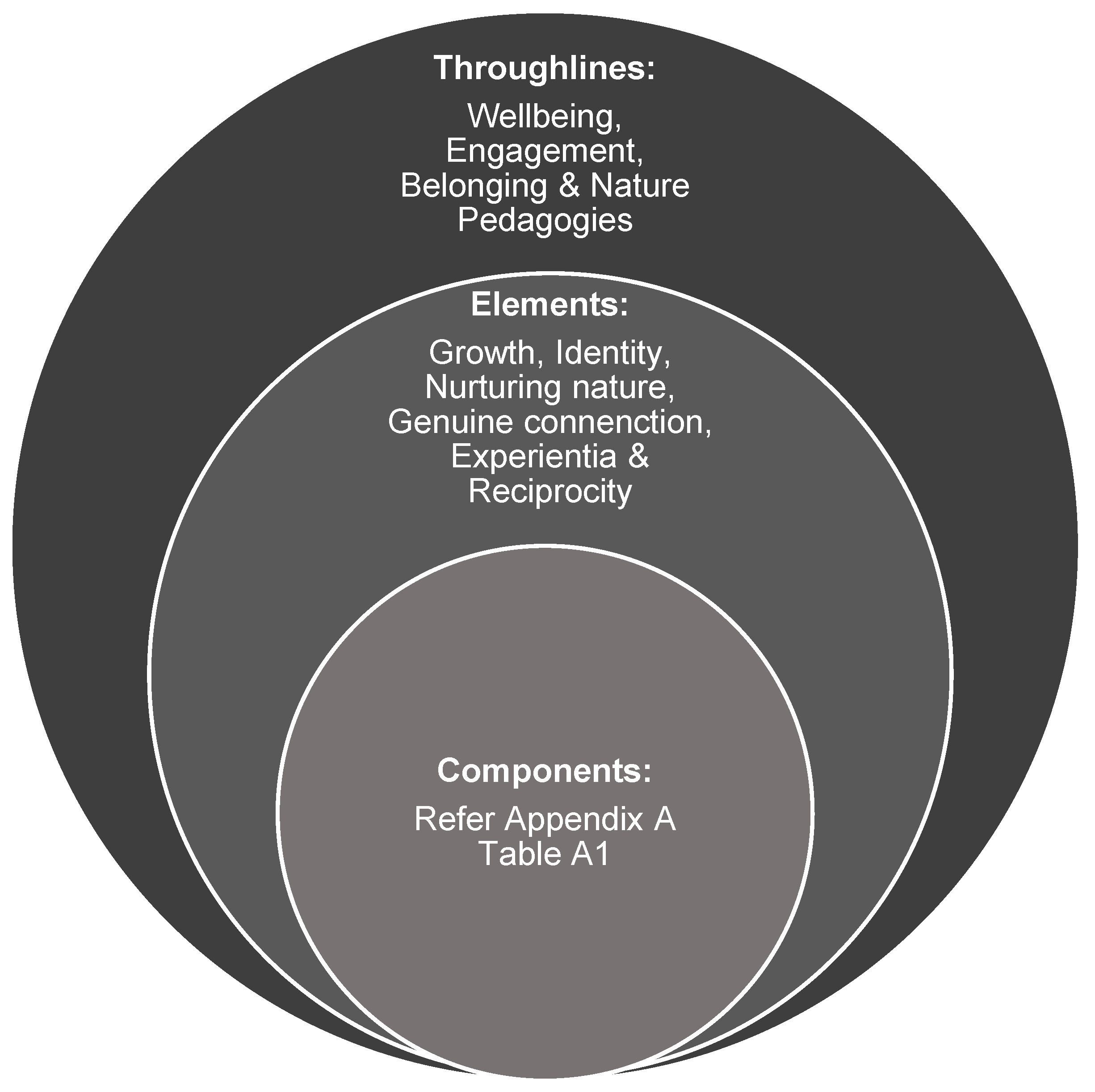

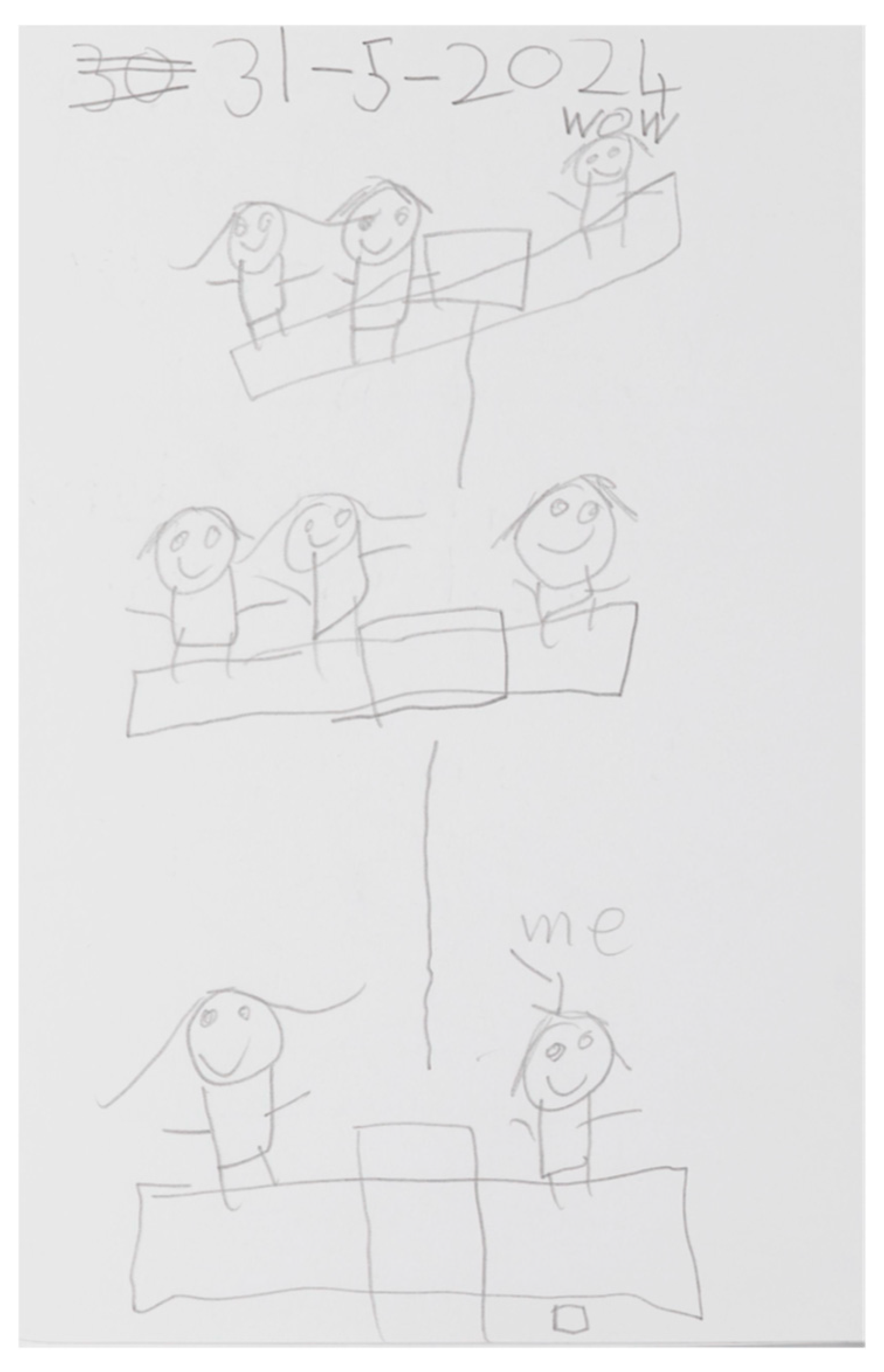
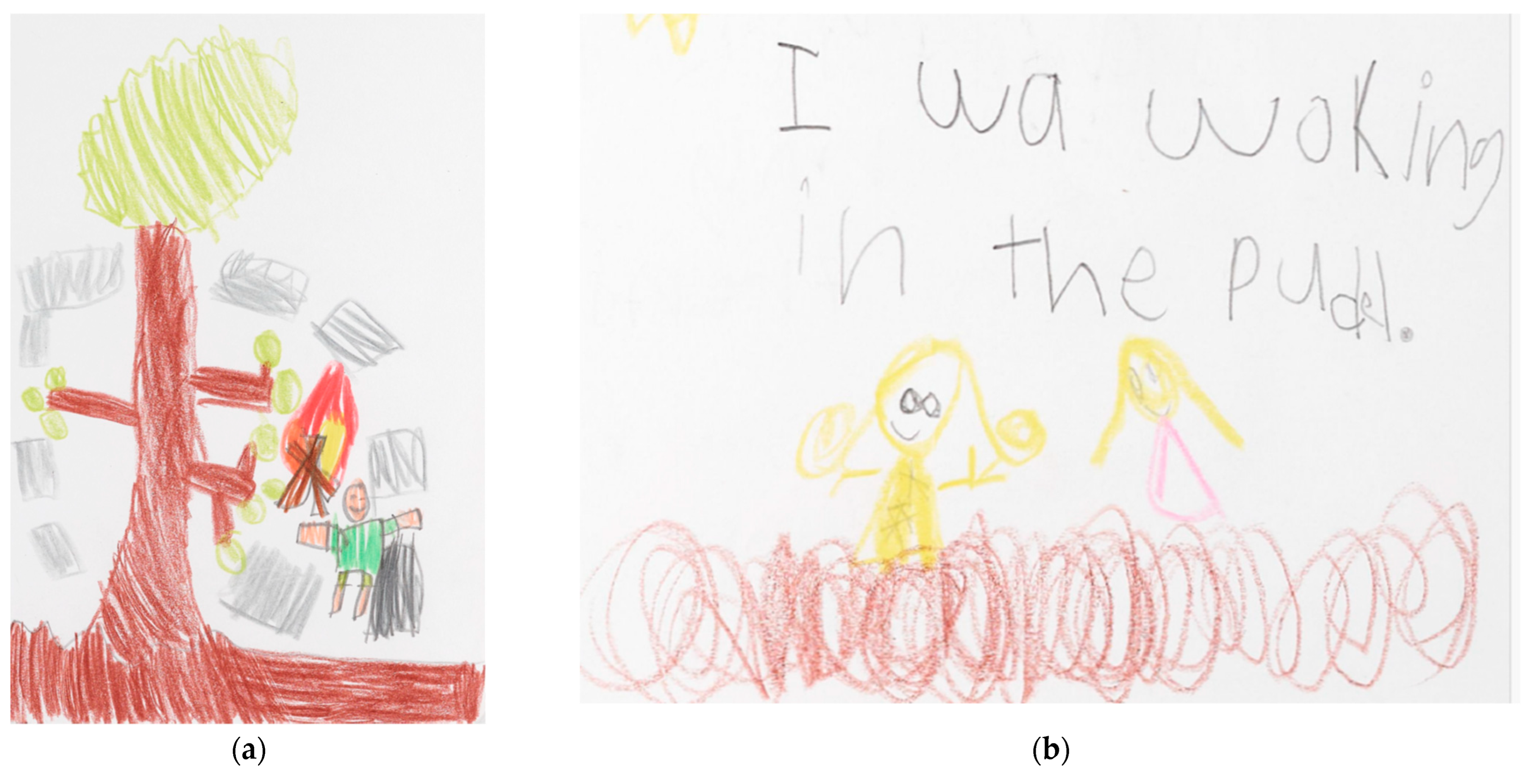
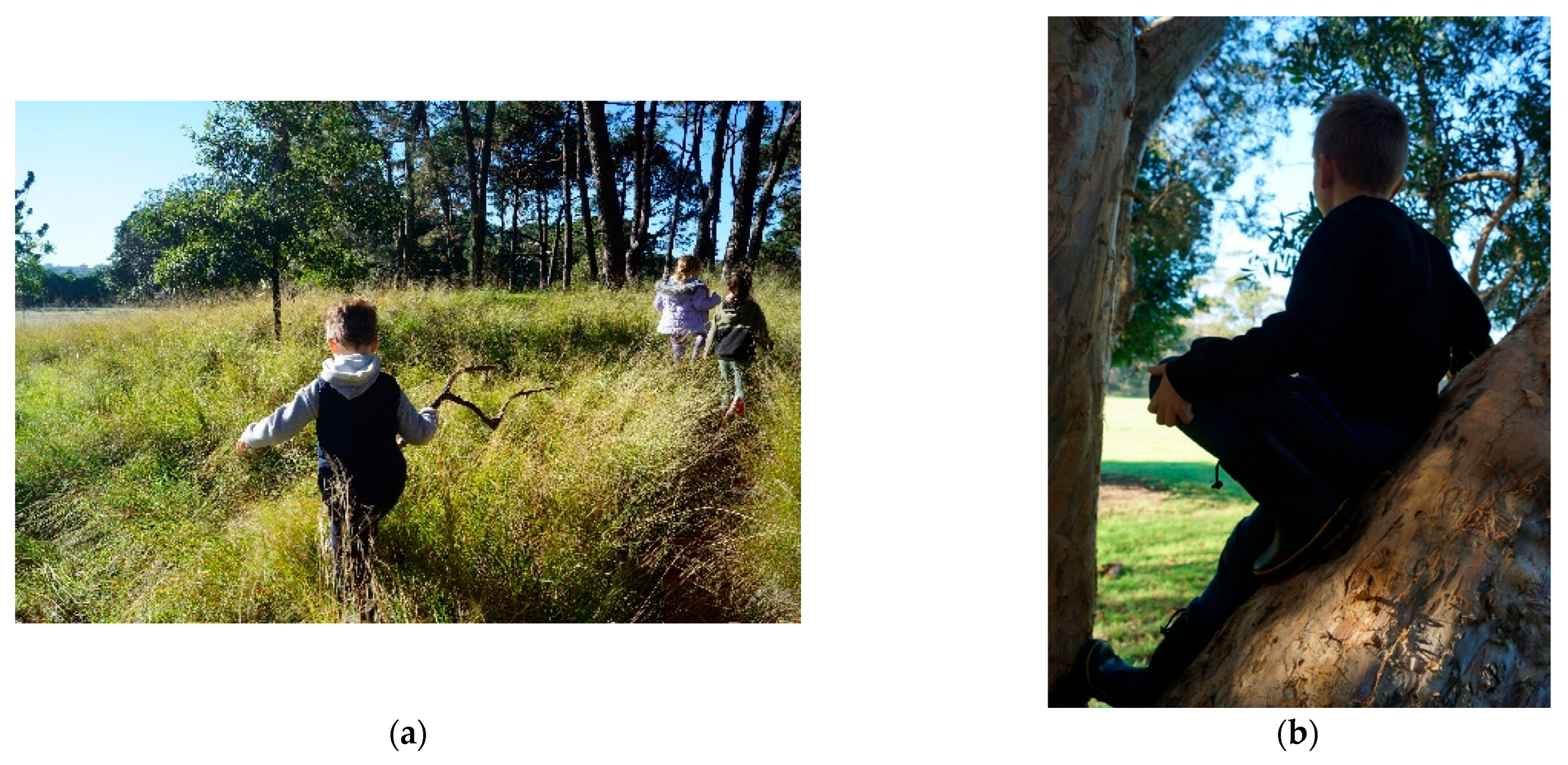
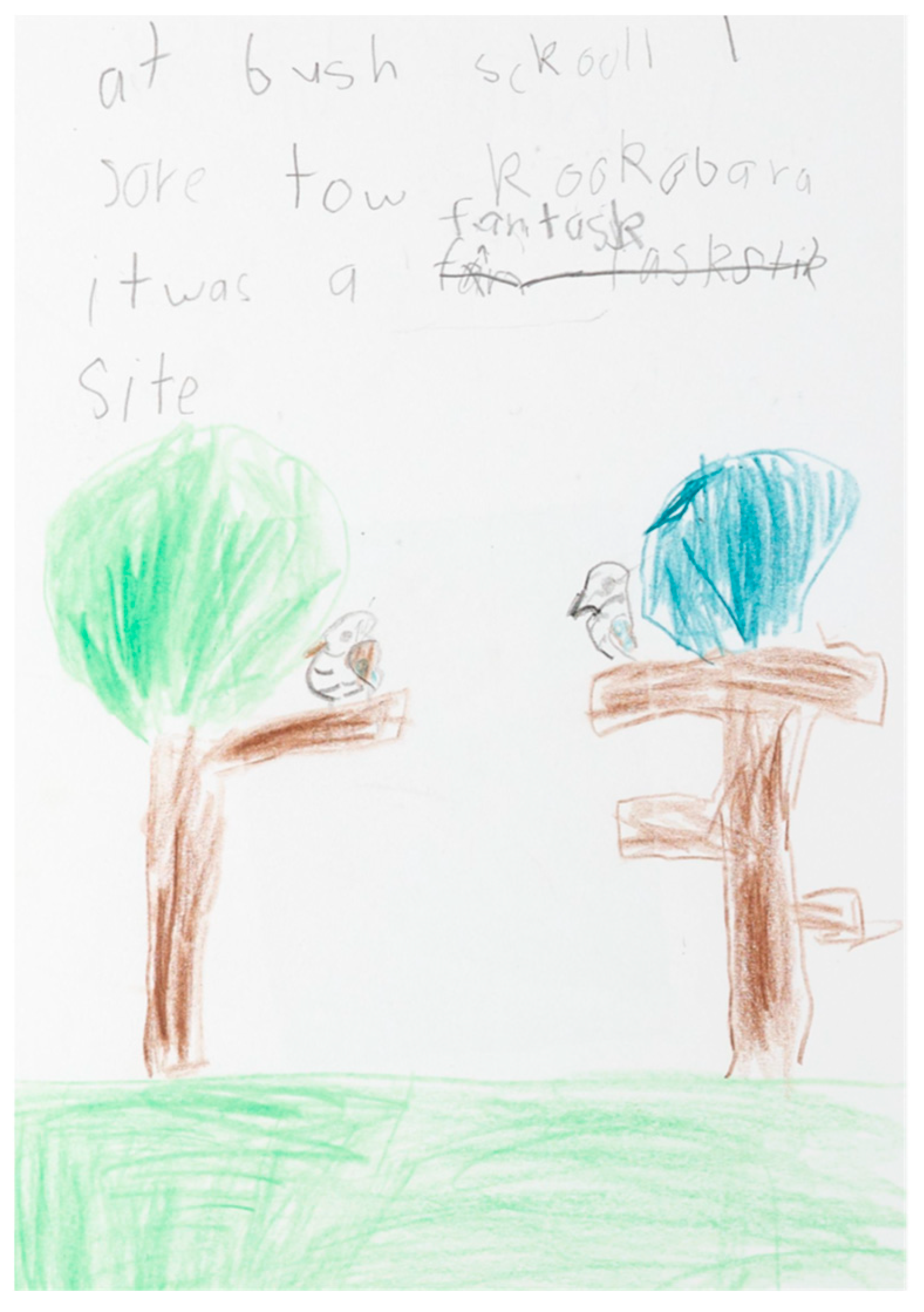
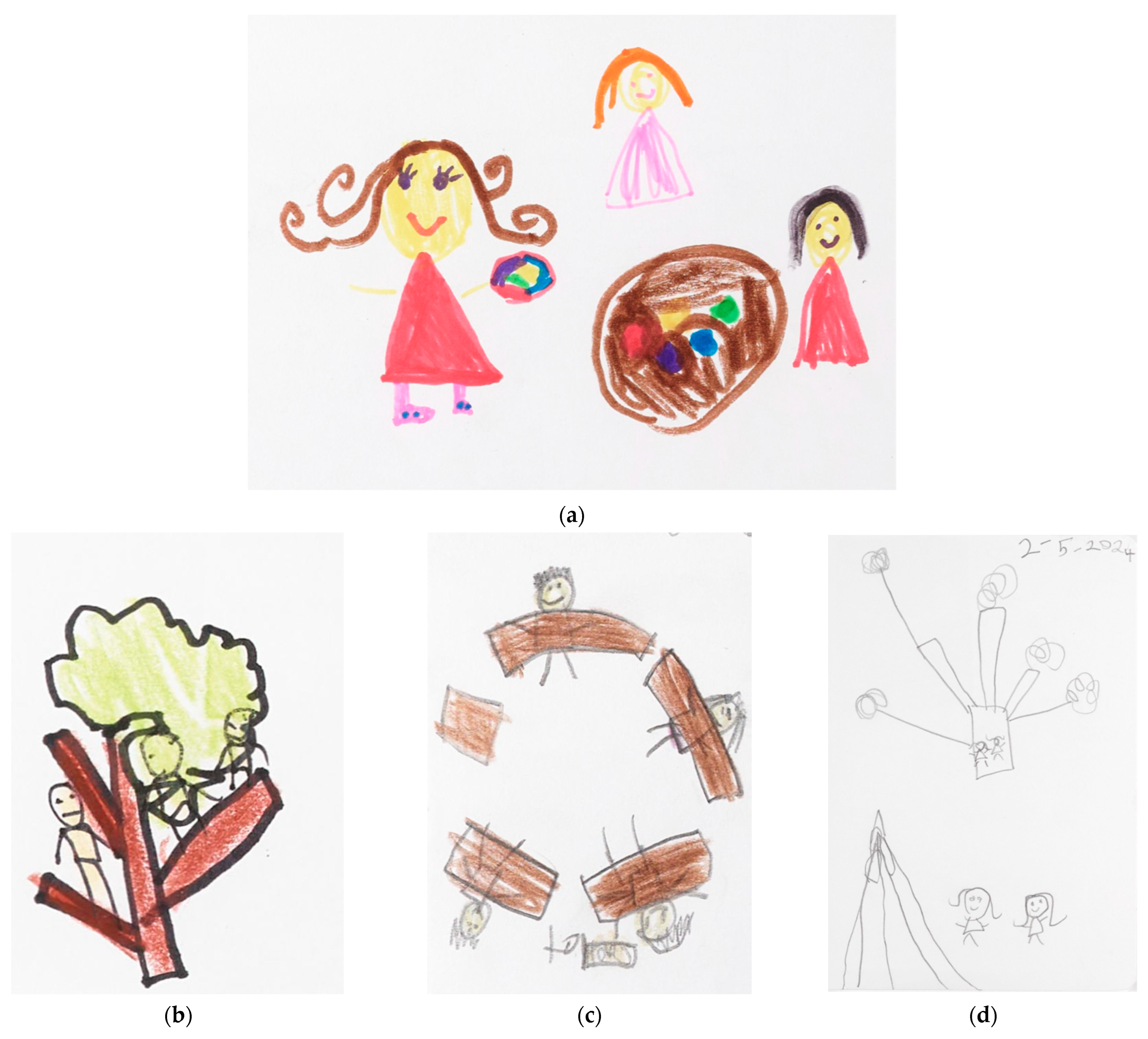
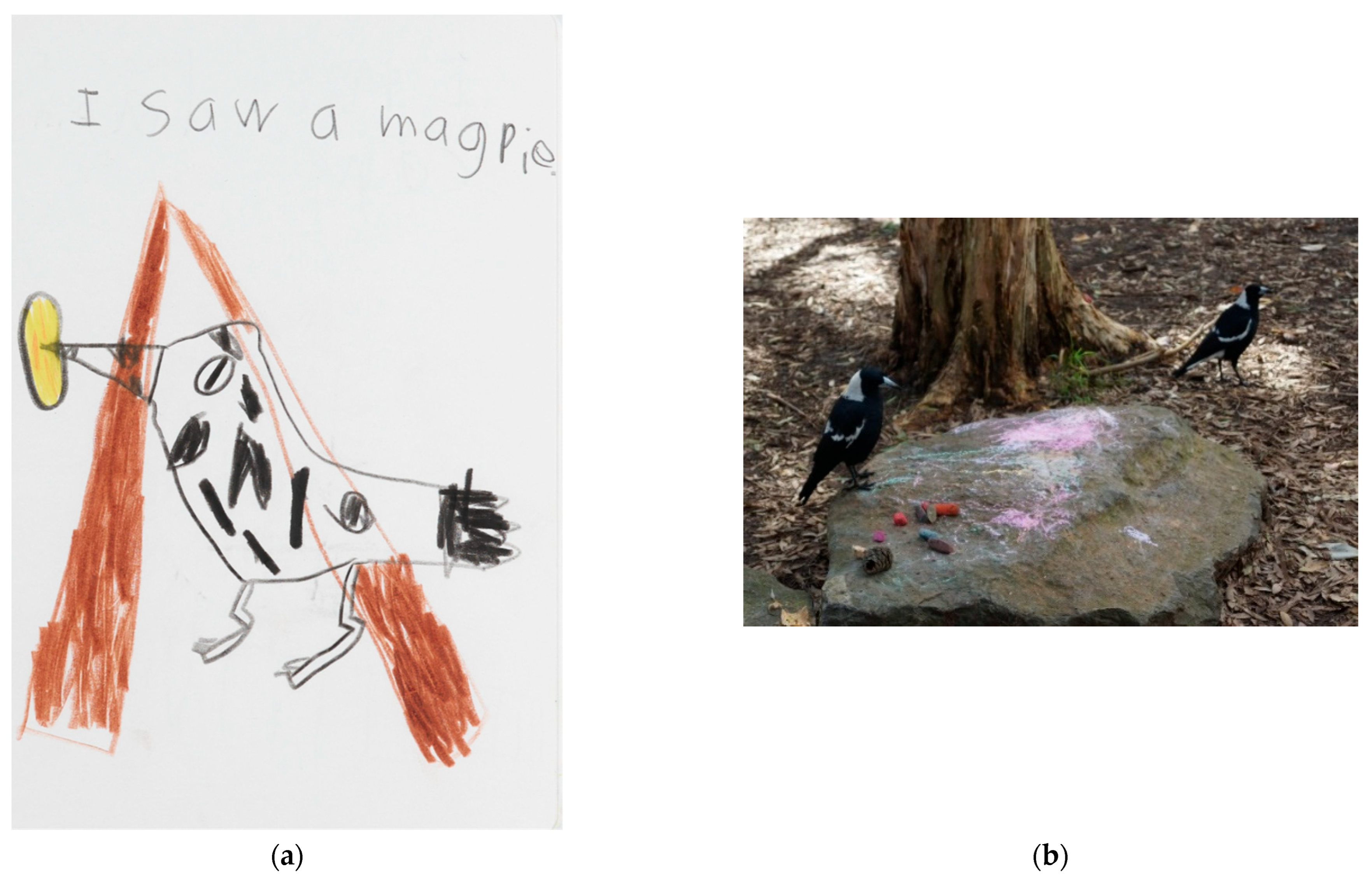
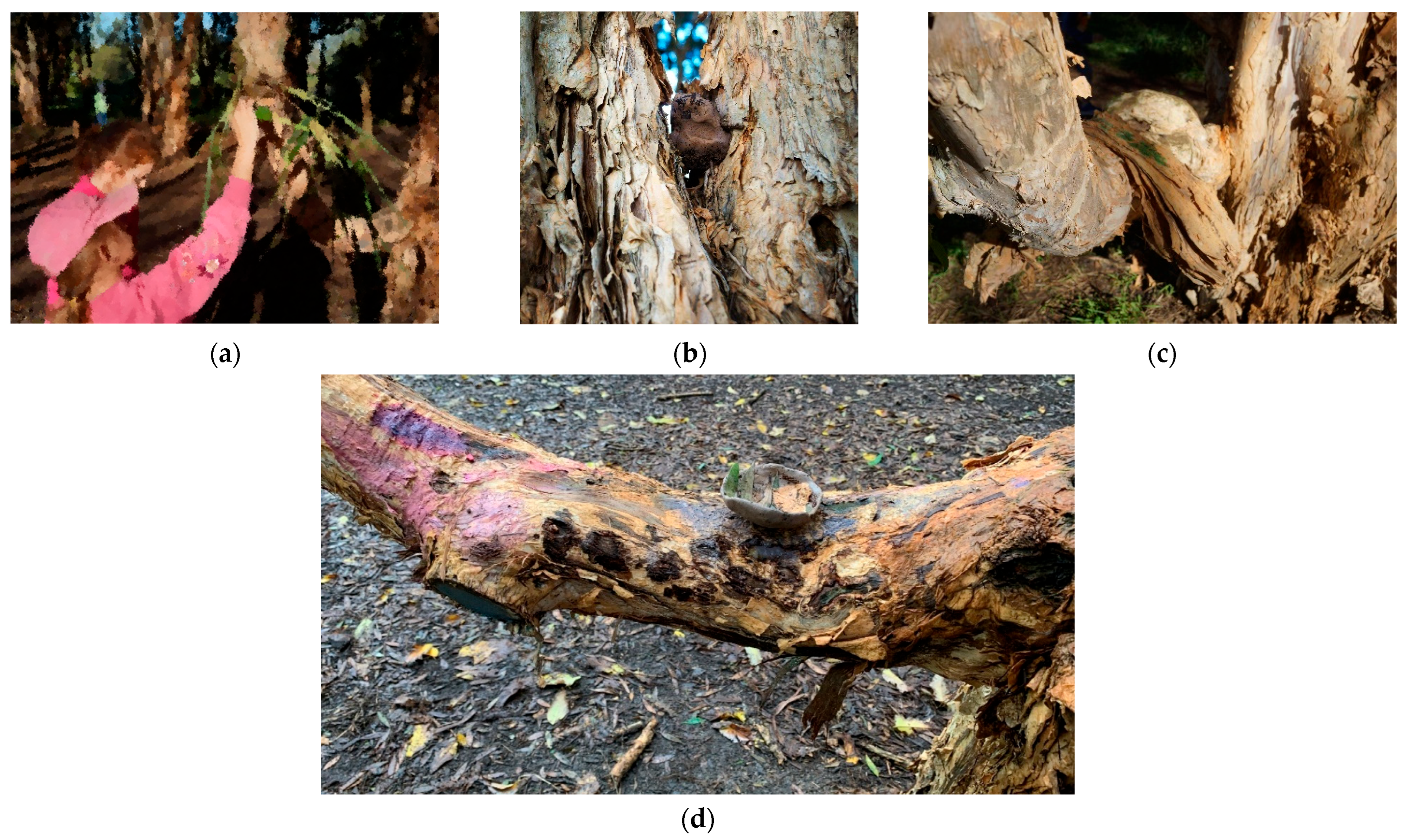
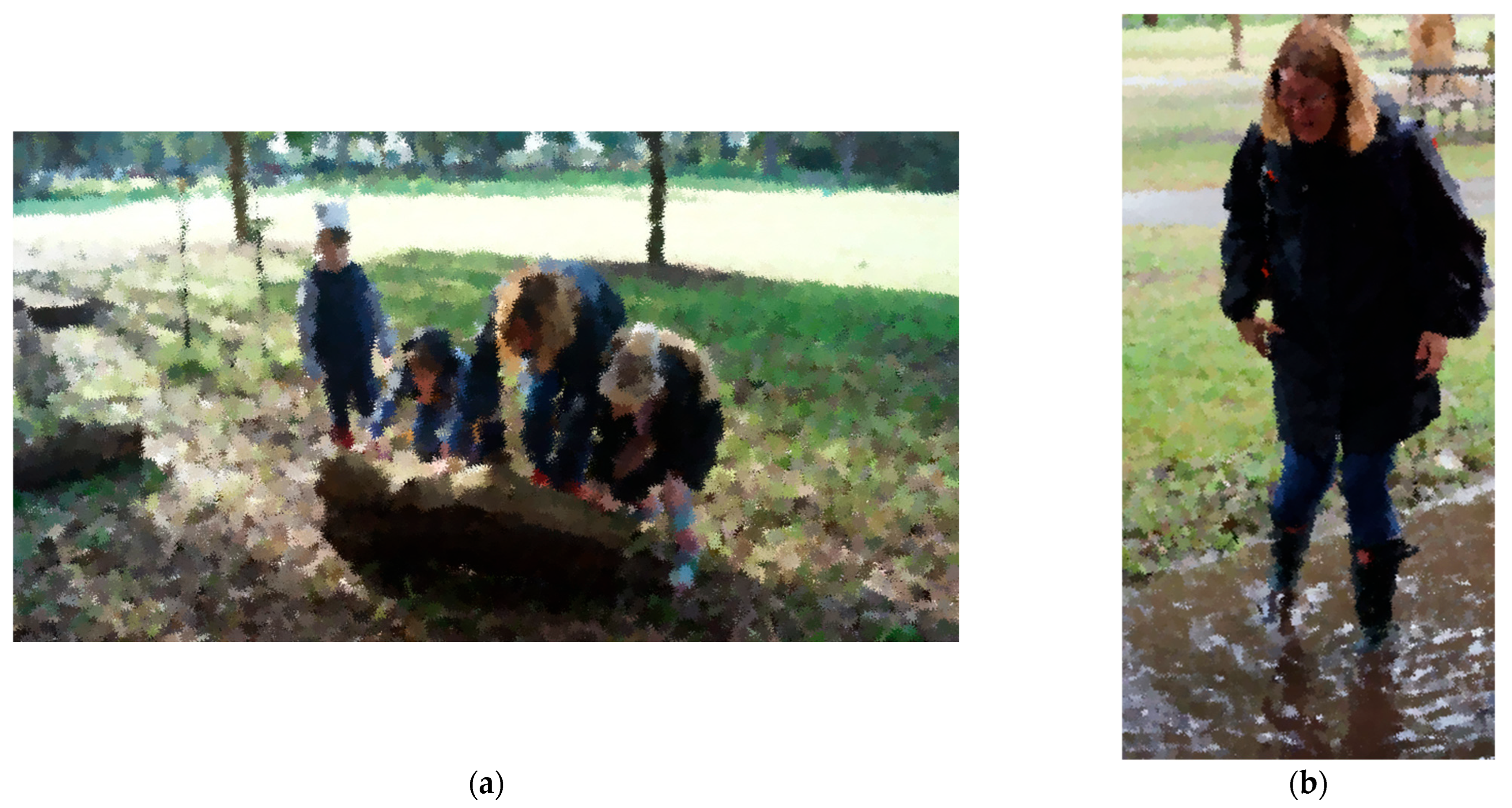
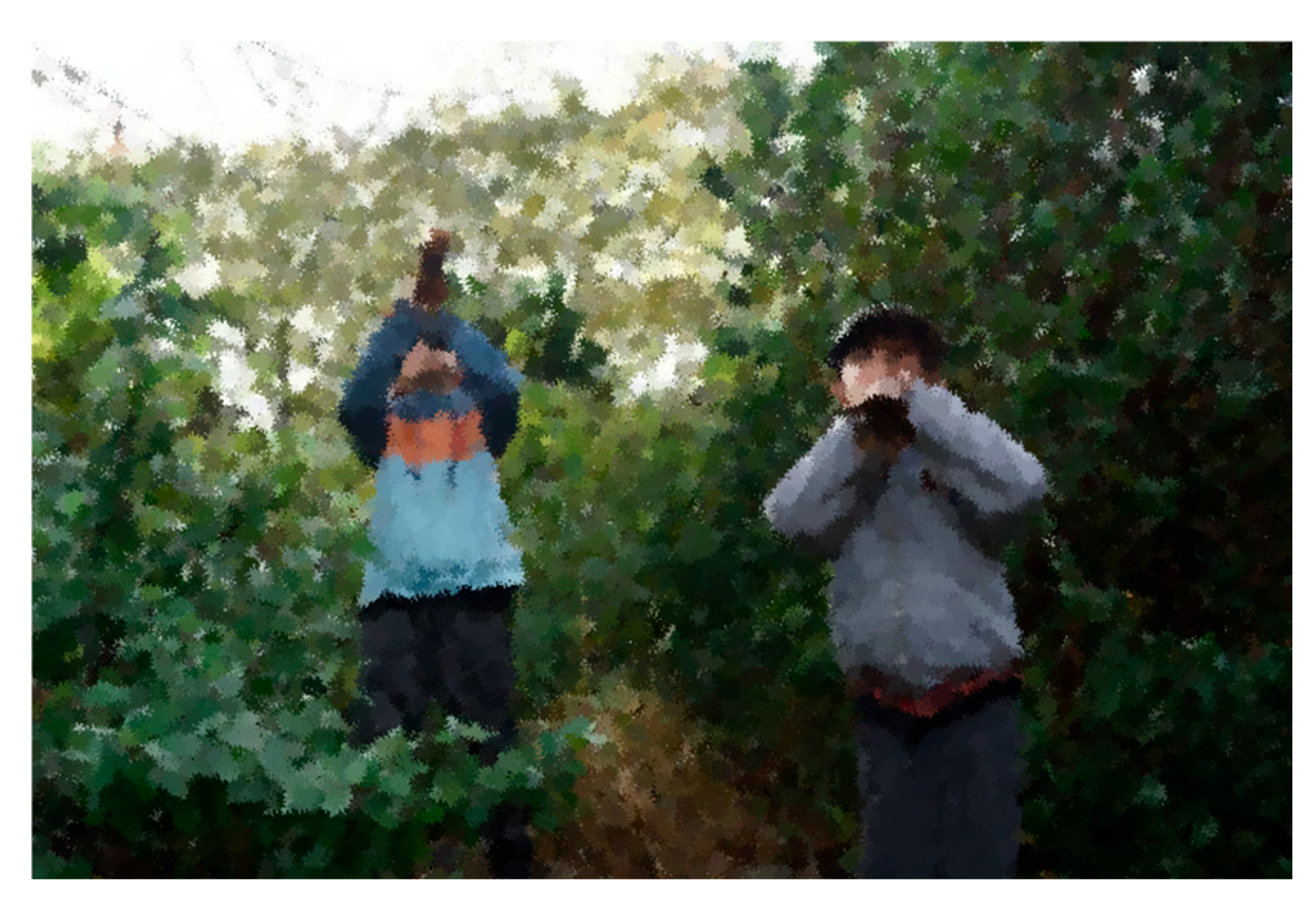
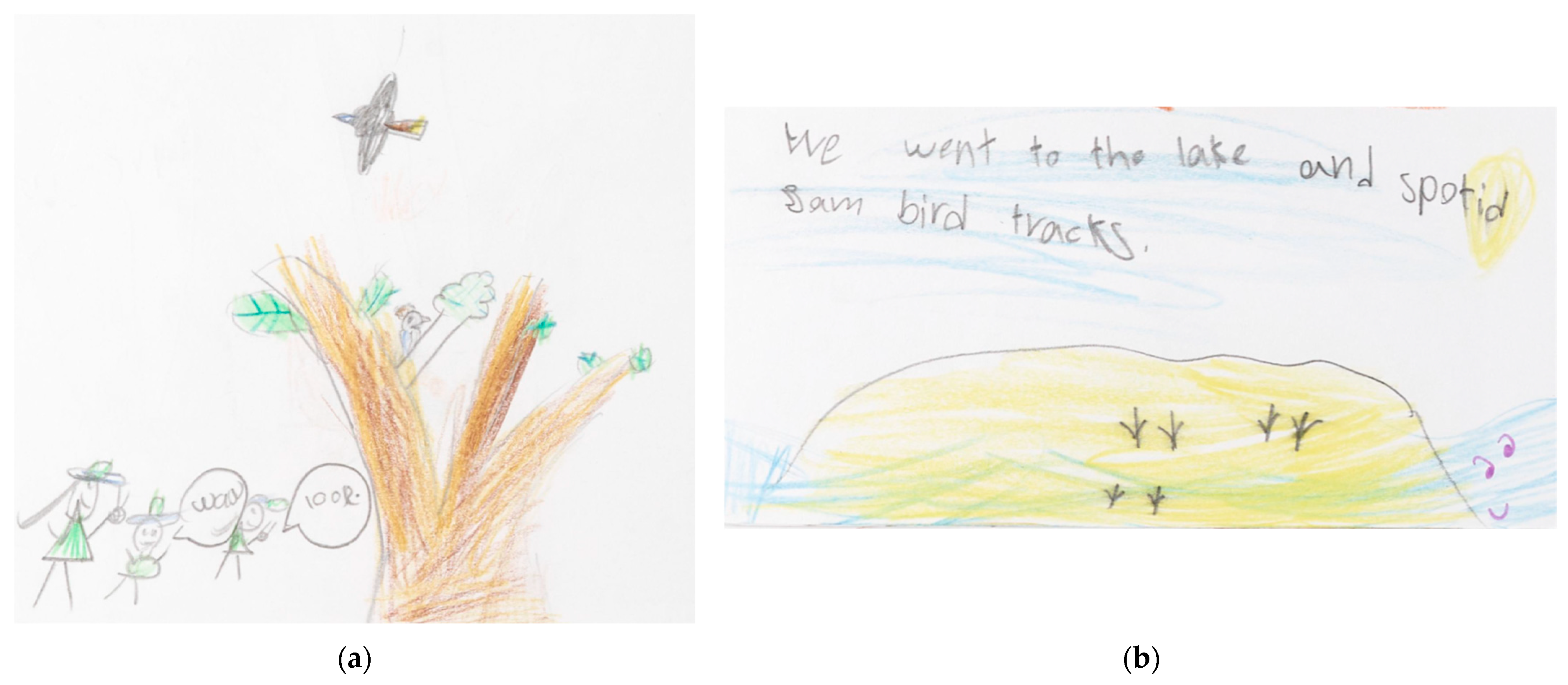
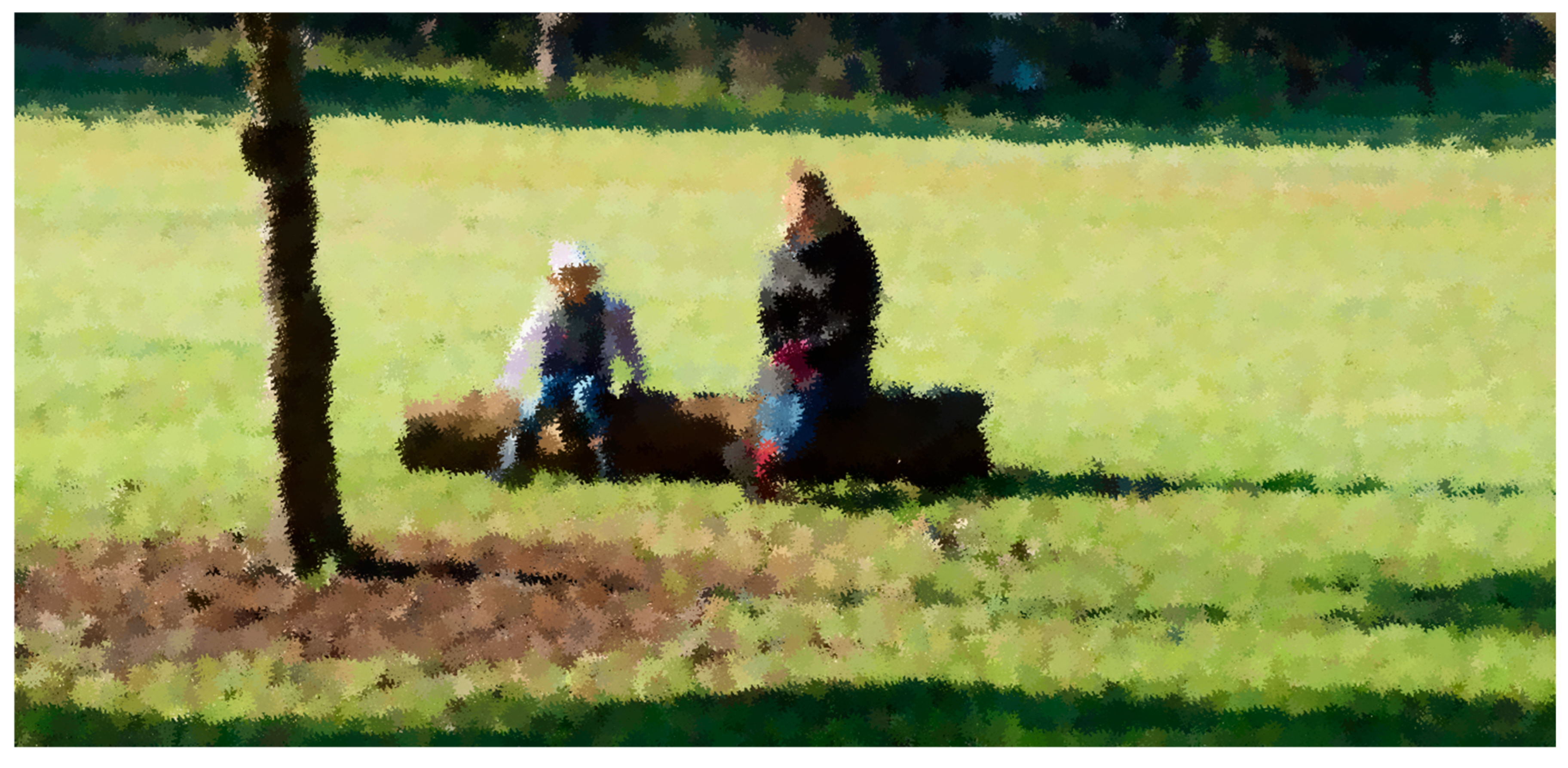
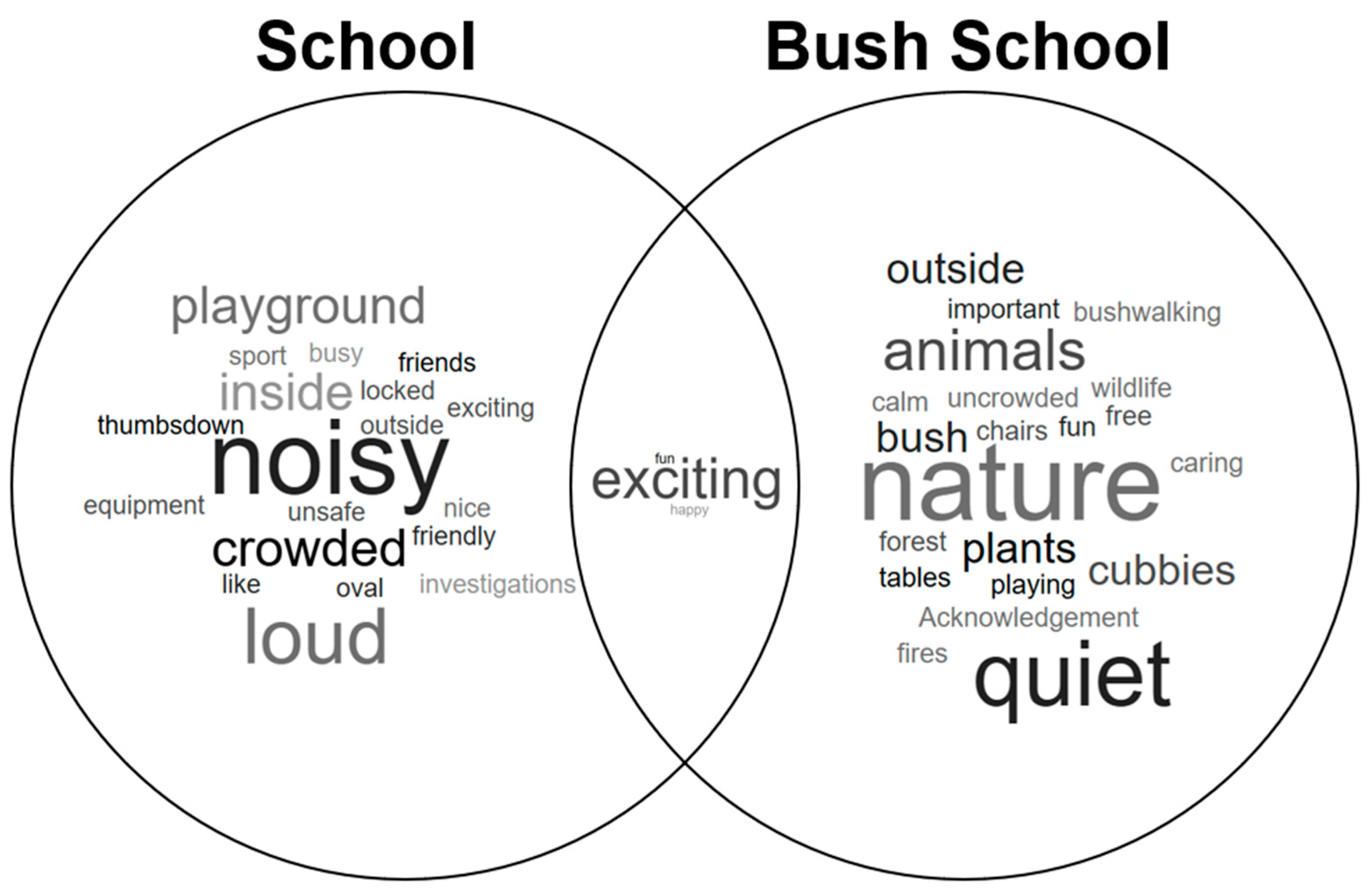
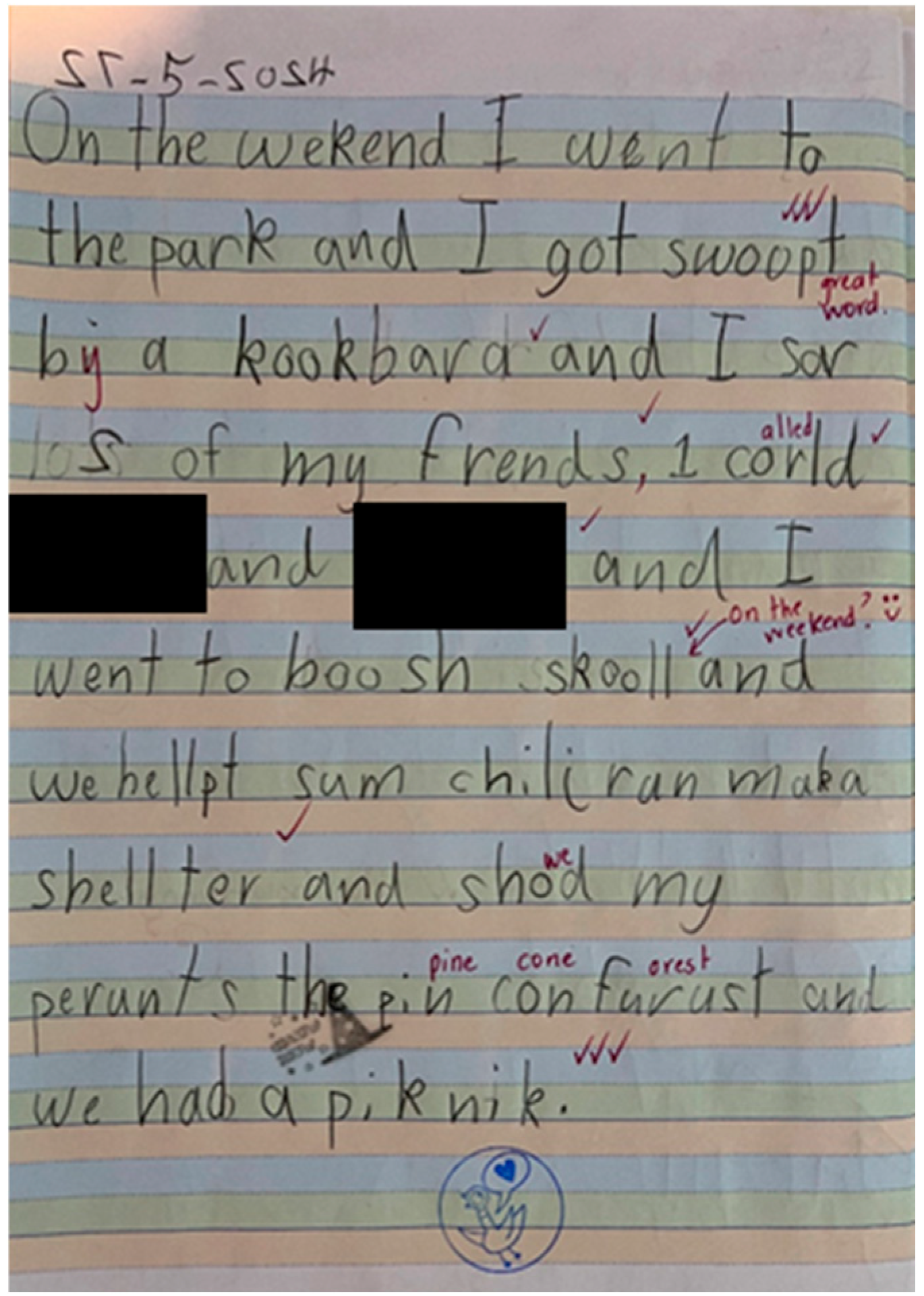
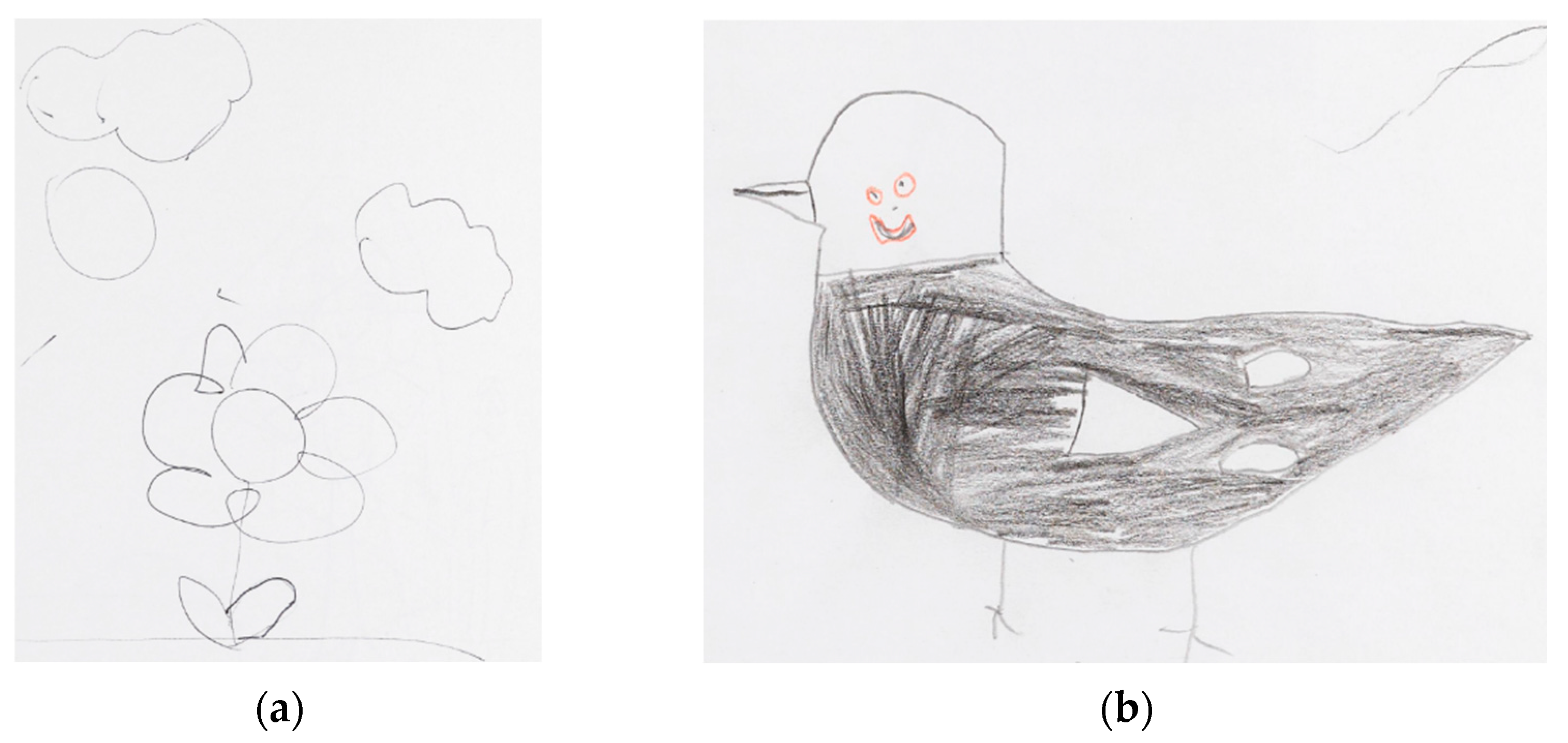
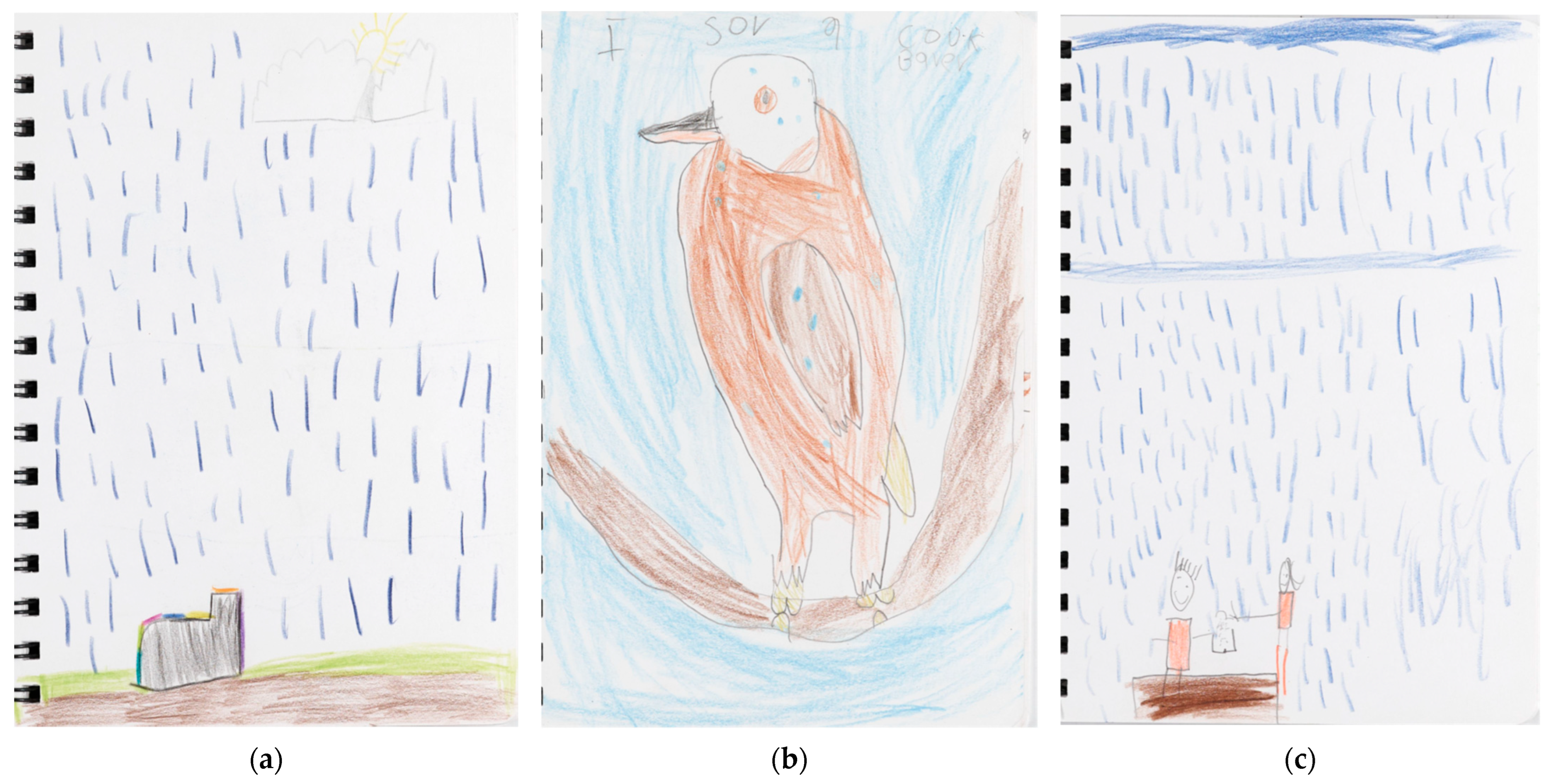
| Data Source | Measure | Timepoints | Participants |
|---|---|---|---|
| PNEW | Quantitative | Pre, Post, Follow-up | Intervention & control |
| PNEW–B | Quantitative | Post, Follow-up | Intervention only |
| Academic Assessments | Quantitative | Pre, Post | Intervention & control |
| Children’s Journals | Qualitative | Post | Intervention |
| Teacher interviews | Qualitative | Pre, Mid, Post | Intervention |
| Parent surveys | Quantitative & Qualitative | Pre, Post-intervention | Intervention |
| Researcher Field Notes | Qualitative | During | Lead researcher |
| Area | Time Point | n | M | SD | Median | z | p | r | 95% CI (Lower-Upper) |
|---|---|---|---|---|---|---|---|---|---|
| Reading | Pre-Test | 25 | 15.72 | 10.39 | 17.00 | — | — | — | [11.43, 20.01] |
| Post-Test | 25 | 19.04 | 11.32 | 30.00 | 3.66 | <0.001 * | 0.52 | [14.37, 23.71] | |
| Mathematics | Pre-Test | 25 | 2.96 | 1.31 | 3.00 | — | — | — | [2.42, 3.50] |
| Post-Test | 25 | 3.24 | 1.20 | 3.00 | 2.67 | 0.008 * | 0.53 | [2.74, 3.74] |
Disclaimer/Publisher’s Note: The statements, opinions and data contained in all publications are solely those of the individual author(s) and contributor(s) and not of MDPI and/or the editor(s). MDPI and/or the editor(s) disclaim responsibility for any injury to people or property resulting from any ideas, methods, instructions or products referred to in the content. |
© 2025 by the authors. Licensee MDPI, Basel, Switzerland. This article is an open access article distributed under the terms and conditions of the Creative Commons Attribution (CC BY) license (https://creativecommons.org/licenses/by/4.0/).
Share and Cite
Harper, A.; Hespos, S.; Gray, T. Nature Play in Primary School: Supporting Holistic Development Through Outdoor Learning. Educ. Sci. 2025, 15, 1487. https://doi.org/10.3390/educsci15111487
Harper A, Hespos S, Gray T. Nature Play in Primary School: Supporting Holistic Development Through Outdoor Learning. Education Sciences. 2025; 15(11):1487. https://doi.org/10.3390/educsci15111487
Chicago/Turabian StyleHarper, Alexandra, Susan Hespos, and Tonia Gray. 2025. "Nature Play in Primary School: Supporting Holistic Development Through Outdoor Learning" Education Sciences 15, no. 11: 1487. https://doi.org/10.3390/educsci15111487
APA StyleHarper, A., Hespos, S., & Gray, T. (2025). Nature Play in Primary School: Supporting Holistic Development Through Outdoor Learning. Education Sciences, 15(11), 1487. https://doi.org/10.3390/educsci15111487







